

Rules of the Road
Right of way rules.
Whenever you meet another boat, it’s like approaching an unmarked intersection in your car. Knowing a few, simple right of way rules will help you avoid a collision. Just as motorists must know what to do when approaching a four way stop, every crossing situation at sea is like approaching an unmarked intersection.
Because there are so many different types of boats and styles of boating, it is important to know what to expect when you come upon another vessel.
"Vessels" are anything that floats on the water that is used, or is capable of being used as a means of transportation on water. A log, a bathtub and many other things could be considered a vessel under the Navigation Rules. The Navigation Rules distinguish one vessel from another by both its design, and by its actions. This section covers maneuvering rules only.
There are other navigation rules that you are required to know. Sound Rules are covered under the Sound Signaling Equipment section. Light Rules are covered under the Navigation Light Equipment section.
The Rules of the Road are published by the U. S. Government Printing Office, and are available in any boating supply stores. Every boat owner should have a copy, but they are mandatory to be kept on vessels over 12 meters (39.4 feet) in length.
The Rules generally used in this course are Inland Rules, unless otherwise noted. There are small but important differences in the Rules depending on where you are operating your boat. It is your responsibility to know the Navigation Rules for your boating area.
- International Rules - Apply to all vessels upon the high seas and in all waters connected to them that are navigable by seagoing vessels.
- Inland Rules - Apply to all vessels upon the inland waters of the United States, and to vessels of the United States on the Canadian waters of the Great Lakes to the extent that there is no conflict with Canadian law. Certain inland waterways may have specific provisions that apply to certain vessels.
- Great Lakes - Includes the Great Lakes and their connecting and tributary waters including the Calumet River as far as the Thomas J. O'Brien Lock and Controlling Works (between mile 326 and 327), the Chicago River as far as the east side of the Ashland Avenue Bridge (between mile 321 and 322), and the Saint Lawrence River as far east as the lower exit of Saint Lambert Lock.
- Western Rivers - Includes the Mississippi River, its tributaries, South Pass, and Southwest Pass, to the navigational demarcation lines dividing the high seas from harbors, rivers, and other inland waters of the United States, and the Port Allen-Morgan City Alternate Route, and that part of the Atchafalaya River above its junction with the Port Allen-Morgan City Alternate Route including the Old River and the Red River.
Vessel Types
- Power Driven Vessel - Any vessel propelled by machinery. This includes any boat that has an engine. Sailboats are considered powerboats when they are being propelled by a motor - even if the sails are up.
- Sailing Vessel - Any vessel under sail alone. Remember, if being propelled by a motor, a sailboat is considered to be a powerboat.
- Vessels Engaged in Fishing - Means any vessel fishing with nets, lines, trawls or other fishing apparatus which restrict maneuverability, but does not include a vessel fishing with trolling lines or other fishing gear which doesn't restrict maneuverability. This means a shrimper out of Galveston is "engaged in fishing" Someone out trolling for stripers in their Grady-White is NOT considered to be engaged in fishing under the Rules.
- Seaplanes - Are any aircraft designed to operate on the water.
- Vessels Constrained by Draft - Means that a vessel can't deviate from a course/channel because they might run aground. A freighter in a narrow channel is an example of this. Note: This is for International waters only, not Inland.
- Vessels Restricted in Their Ability to Maneuver - Means a vessel that can't maneuver as required by the rules because of the size or operation of the vessel. A fishing vessel pulling in nets and a buoy tender placing a buoy are both examples of a vessel restricted in their ability to maneuver.
- Vessels not under Command - Any vessel that for some exceptional circumstance is unable to maneuver as required by the Rules, and is therefore unable to keep out of the way of another vessel. If Joe boater slips and knocks himself out, and can no longer steer--that's a vessel not under command. If the steering cable goes out, and you can't turn the boat, that's a vessel not under command. If the captain is not paying attention and hits another boat, that's negligence.
- Underway - Means that you are not anchored, moored, at the dock, or aground. If you are even drifting along, you are underway.
- Restricted Visibility - Means any condition such as fog, mist, falling snow, rain, or other similar causes that make it difficult to see other vessels. Losing your glasses is NOT restricted visibility.
Rule, Rule, Rule your Boat
It may seem as if you can do anything you want while you are on the water (You might also think that it looks as if everyone else is going crazy on the water). Boating on a crowded waterway can be scary! The good news is that there are rules to govern the action of each vessel. The bad news is that many vessel operators do not know the rules!
Not complying with the Rules - even if you don't know them, can get you in trouble on the water. Even if you think you are following the Rules, if there is something that you can do to avoid a collision - you must do it, even if you deviate from a different Navigation Rule.
It is your responsibility as the ship's captain to be aware of your surroundings at all times, and to operate your vessel in a safe manner. Caution may not be fun, but having an accident sure stinks.
The Rules state that every vessel shall use all available means appropriate to the prevailing conditions to determine if a risk of collision exists. If there is any doubt, such risk shall be deemed to exist.
Rules Explained
The Rules are designed to tell you what to do when you operate your vessel near other vessels. The purpose of the Rules of the Road is to help you avoid an accident--not to establish responsibility or liability if you get into an accident. - Remember, if you get into an accident, you can be held liable, even if you followed the Rules to the letter!
Your primary obligation is to operate in a safe manner. Under the Rules, there is no "right-of-way" like there is on a street. For most situations, Boats are called one of the following.
- Give-Way Vessel - If you are the Give-Way vessel, you must act as if the "stand-on" vessel has the right to keep going the way it is going. It is your responsibility to signal your intentions to the stand-on vessel, and it is your responsibility to maneuver your boat around the other in a safe manner. Also known as a "Burdened" vessel, as it has the burden of.
- Stand-On Vessel - If you are the Stand-On vessel, it is your responsibility to acknowledge the intended actions of the give-way vessel. You must also maintain your current course and speed until the give-way vessel passes, or you enter a dangerous situation.
Operator Responsibilities
In addition to the Rules, you have other responsibilities as the captain as well. You are responsible for the safety of everyone aboard your vessel at all times--and you have a responsibility to those with whom you are sharing the water.
- You must always operate at a safe controlled speed for the situation in which you are boating, and any legally mandated speed requirements that there may be, such as a slow/no wake zone.
- Take care to avoid careless, reckless or negligent boat operations--such as operating too closely to other vessels, boating under the influence, or operating at an unsafe speed for the given conditions.
- Steer clear of naval vessels, and other restricted facilities such as bridges, power plants and dams. New Homeland security measures require it, as does your safety! For more information, see the Homeland Security pages.
Finally, as a boater, you have a responsibility to all other boaters--and all others who enjoy the water--to be courteous and respectful of others. This means that you should always watch your boat noise (a legal requirement) avoid congested waters as much as possible, avoid disturbing wildlife and sea grasses, and look out for the safety and well being of other boaters by giving a hand to those in need.
The Pecking Order
There is a "pecking order" that can be used as a simplified memory aid to determine right of way for vessels of different types. Get very familiar with this list, as it is important to understand it thoroughly. The lower most vessel on the list is the give way vessel, and must stay out of the way of vessels that are higher on the list.
- Overtaken vessel (top priority)
- Vessels not under command
- Vessels restricted in their ability to maneuver
- Vessels constrained by draft
- Fishing vessels engaged in fishing, with gear deployed
- Sailing vessels
- Power driven vessels
Collision Avoidance
- Rules apply to vessels in all conditions of visibility. Rules are the same at night or in fog, for instance, as they are during a bright sunny day.
- Every vessel must maintain a proper look-out by sight and hearing at all times. Operator inattention and not having an adequate look out are a leading cause of accidents each year.
- Every vessel must proceed at a safe speed at all times. Several factors should be considered when determining safe speed, including but not limited to the state of visibility, traffic density, your vessel's maneuverability, with special reference to stopping distance and turning ability. At night, consider the presence of background lights such as those from shore, or from the back-scatter of your vessel's own lights. Consider also the state of wind, sea, and current, and the proximity of navigational hazards.
- The Rules specifically require that any action taken to avoid collision, if the circumstances allow, will be positive, made in ample time, and in keeping with good seamanship. Any changes in course or speed should be large enough to be readily apparent to the other vessel. This means that you should avoid last second changes in course, and you should avoid a small series of changes. Change direction early, and make a large turn.
Maneuvering
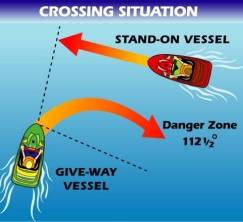
The main situations of collision risk are overtaking, meeting head-on, and crossing. When one of two vessels is to keep out of the way (give-way vessel), the other, the stand-on vessel, must maintain course and speed. The stand-on vessel must take avoiding action when it becomes apparent that the vessel required to give way is not taking appropriate action.
The Crossing Rule
Both International and Inland Rules state that when two power-driven vessels are crossing so as to involve risk of collision, the vessel which has the other on her starboard side (the give-way vessel) must keep out of the way.
As the give-way vessel it is your duty to avoid a collision. Typically, this means you must alter speed or direction to cross behind the other vessel (the stand-on vessel).
At night, if you see a red light crossing right-to-left in front of you, you need to change your course. If you see a green light crossing from left-to-right, you are the stand-on vessel, and should maintain course and speed.
The Meeting Situation
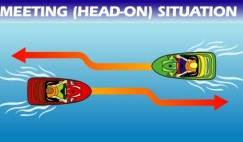
At times there may be some doubt whether the situation is a crossing or a head-on meeting. In case of doubt, you should assume that it is a meeting situation, in which neither vessel has a clear-cut "right-of-way," and each must act to avoid the other. Each vessel in a meeting situation must alter course to starboard so that each will pass on the port side of the other. At night, you will recognize a head-on meeting situation if you see both red and green side lights at the same time.
The Overtaking Situation
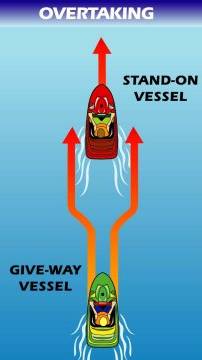
Any vessel overtaking any other vessel must keep out the way of the vessel being overtaken. The former is the give-way vessel and the latter is the stand-on vessel.
This rule applies even if the overtaking vessel is propelled by wind, oars, or rubber band paddlewheel.
A vessel is deemed to be overtaking when coming up with another vessel from a direction more than 22.5 degrees abaft (behind) her beam. This is the angle prescribed by the stern light.
At night, the overtaking vessel will see only the white stern light of the vessel being overtaken. If you see either side light, it is a crossing situation.
Operating in a Narrow Channel
First and foremost, you have to avoid larger vessels that can only travel in a channel. Even if your vessel is operating under the rules otherwise, you must give way to a boat that could potentially run aground or get into a collision if they left the channel.
Try and operate on the edge of the channel. Be extra cautious if you come to a bend in the waterway, and can't see traffic coming towards you.
You may sound a prolonged blast as a warning to traffic headed your way.
On the Great Lakes and Western River system, vessels going downstream are stand-on, vessels going up stream must give-way.
Potential Collision Situation
When the distance between two vessels decreases and the relative angle of the other vessel off the bow remains the same, then you will soon be trying to occupy the same spot in the water - a collision situation. Change course or reduce speed, even if you are the stand-on vessel.
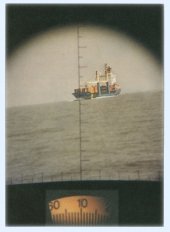
Conduct of Vessels During Periods of Restricted Visibilty
Operating a boat in areas or at times of restricted visibility requires extra concentration by the skipper and the lookout. You must operate your vessel at a speed at which you can identify and react to a situation and still have enough time to avoid a collision. This is especially important when vessels are no in sight of one another.
- Operate at a safe speed for the prevailing circumstances
- Have engines ready for immediate maneuvering - including reverse
- Don't rely on radar or other electronic imaging alone - use your buiilt in senses at all times
- Take avoiding actions early and provide ample time for the other vessels to maneuver
- Avoid sharp turns if being overtaken
- Always - you are in doubt, reduce your speed
- Every vessel shall at all times proceed at a safe speed
Other Rules
Whether under inland or international rules, power vessels must keep clear of sailing vessels in open waters. A sailboat with motor running is defined as a motor boat. The "pecking order" between sailing vessels is more complex. When two sailing are approaching one another so as to involve risk of collision, one of then shall keep out of the way of each other as follows.
- When each has the wind on a different side, the vessel which has the wind on the port side shall keep out of the way of the other.
- When both have the wind on the same side, the vessel which is to windward shall keep out of the way of the vessel which is to leeward.
- If a vessel with the wind on the port side sees a vessel to windward and cannot determine with certainty whether the other vessel has the wind on the port or the starboard side, she shall keep out of the way of the other.
- For the purposes of these rules the windward side shall be deemed to be the side opposite to that on which the mainsail is carried. On square-rigged vessels, it shall be deemed to be the side opposite to that on which the largest fore-and-aft sail is carried.
Now that you are familiar with "The Rules," go out and use them in passing, meeting, and crossing situations you find on the water. You will get many puzzled looks from inexperienced boaters with no training or testing.
Remember, if a collision does occur, your proper use of the correct signals and appropriate actions will win you points! But you know enough now to avoid a collision.
The navigation rules of the road contained in this course summarize basic navigation rules for which a boat operator is responsible. Additional and more in-depth rules apply regarding various types of waterways and operation in relation to commercial vessels and other watercraft. It is the responsibility of a boat operator to know and follow all the navigation rules.
For a complete listing of the navigation rules, refer to the document “Navigation Rules of the Road” published by the U.S. Coast Guard (COMDTINST 16672.2 Series) and available through the U.S. Government printing office or on the web here .
For state specific navigation requirements, refer to the state laws where you intend to boat.
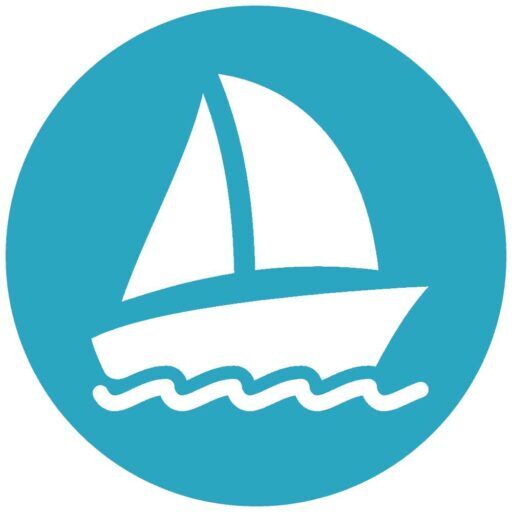
WaterCraft 101
Your guide to fun on the water!
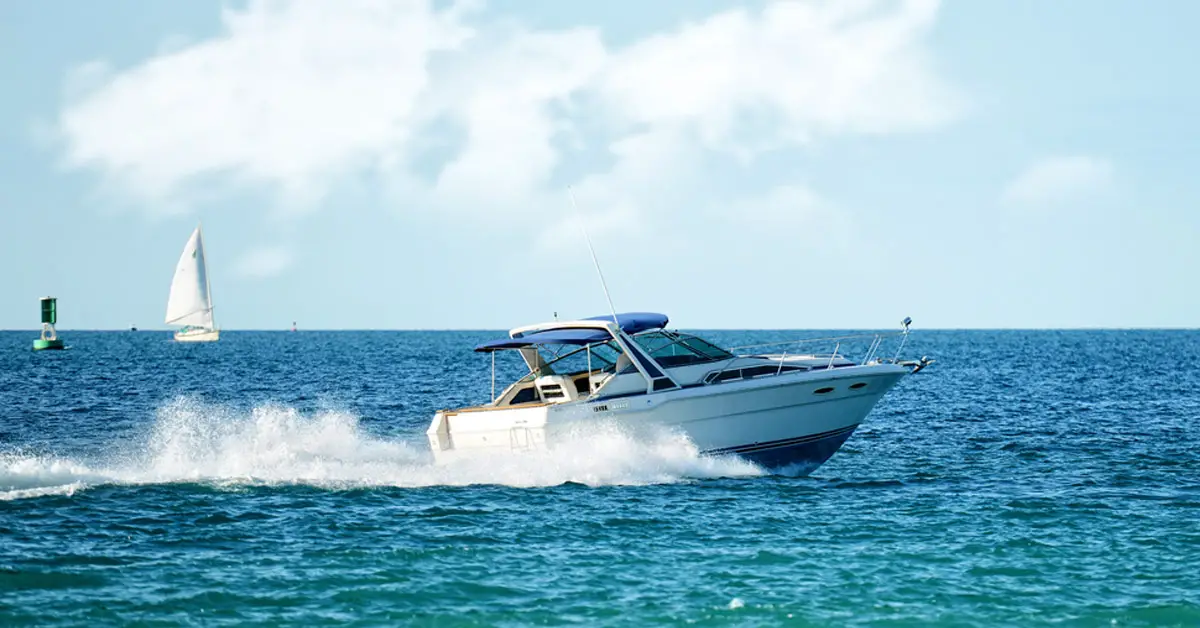
Sailboat vs. Powerboat: Which Is the Give-Way Vessel? Understanding Navigation Rules on the Water
Navigating the waters is an exciting adventure, whether you’re at the helm of a sleek sailboat or commanding a powerful motorboat. However, along with this thrilling journey comes the responsibility of understanding and adhering to the marine navigation rules, specifically those concerning the right of way or the “give-way” vessel. This aspect is vital to maritime safety, ensuring orderly movement and preventing potential collisions on the high seas.
Under the International Regulations for Preventing Collisions at Sea (COLREGs), a powerboat is typically the give-way vessel when encountering a sailboat under sail. The powerboat should alter its course to avoid a collision. Always confirm specific situations with local and international rules.
This article will delve into the intriguing debate between sailboats and powerboats. We’ll dissect the intricate navigation rules on the water, shedding light on the factors determining which boat must yield.
This piece promises to be an enlightening read for seasoned mariners and beginners alike, providing essential information for anyone who wishes to tackle the waves responsibly. Remember, knowing these rules isn’t just a matter of etiquette—it’s a crucial component of maritime safety.
Table of Contents
Introduction to Nautical Navigation Rules
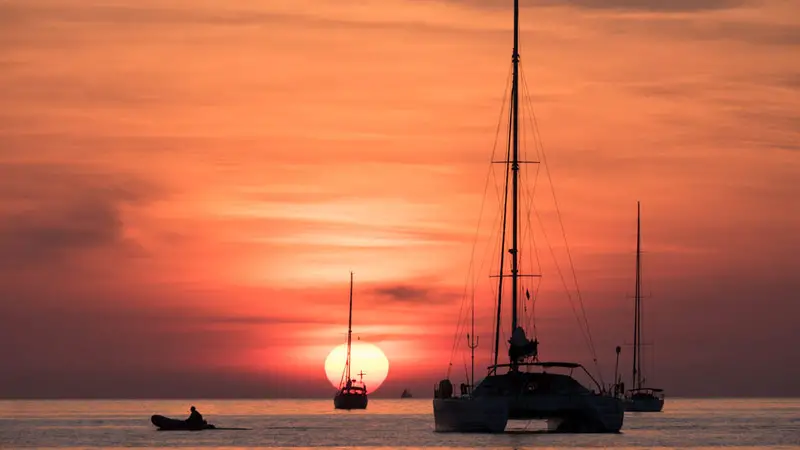
Navigating the vast expanse of our world’s waters requires skill and a profound understanding of maritime movement rules. These rules, known as the International Regulations for Preventing Collisions at Sea (COLREGs), have been established by the International Maritime Organization (IMO) and are adhered to by seafarers worldwide. They provide a comprehensive framework for nautical navigation, ensuring that all vessels move in a safe and orderly manner.
Key points in understanding nautical navigation rules include:
- Understanding COLREGs: COLREGs are the universal road rules for boats and ships worldwide to prevent collisions between two or more vessels.
- Right of Way or Give-Way Rules: These rules determine which vessel is responsible for keeping out of the way in encounters with other vessels to avoid collisions.
- Sound and Light Signals: COLREGs establish a system of sound and light signals so vessels can communicate their intentions in various scenarios, especially in poor visibility.
- Navigation Lights and Shapes: Vessels must display specific lights and shapes in different situations to indicate their status to other vessels.
- Steering and Sailing Rules: These rules determine vessels’ actions in the sight of one another to prevent collisions.
- Special Circumstances: There are also rules for special circumstances, such as vessels not under command, constrained by draft, engaged in fishing , or sailing in narrow channels.
Understanding the Concept of the Give-Way Vessel
Understanding the concept of the give-way vessel is fundamental to maritime navigation. In nautical terms, a ‘give-way’ vessel refers to the boat required to alter its course or speed to avoid colliding with another boat, the ‘stand-on’ vessel. Essentially, the give-way vessel must yield to the stand-on vessel.
These designations help create an orderly flow of traffic on the water and significantly reduce the risk of collisions. It’s important to note that these roles can change based on various factors, including the type of vessels involved, their relative positions, and the environmental conditions.
The responsibility of the give-way vessel does not absolve the stand-on vessel of all duties. If it becomes apparent that the give-way vessel is not taking appropriate action to avoid a collision, the stand-on vessel must take evasive action.
Regardless of their designation, both vessels share a mutual obligation to avoid incidents at sea. Understanding these dynamics and responsibilities is crucial for all mariners, as it contributes to safer navigation and fosters a culture of mutual respect and cooperation on the waterways.
Sailboats vs. Powerboats: A Basic Overview
Sailboats and powerboats represent two distinct modes of marine transportation, each with unique characteristics, advantages, and challenges. Sailboats, propelled primarily by wind action on their sails, offer an eco-friendly, serene, and often sportive seafaring way. On the other hand, powerboats, driven by mechanical engines, provide speed, power, and often more control, particularly in challenging weather conditions. Each type requires different skill sets and knowledge to operate safely and efficiently.
Key characteristics of sailboats and powerboats include:
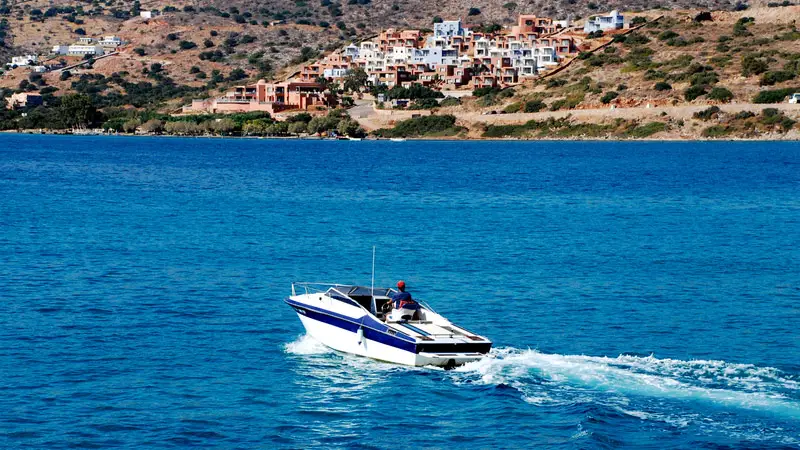
- Propulsion: Sailboats rely on the wind acting on sails, rigging, and hull for propulsion. In contrast, powerboats use engines (inboard, outboard, or stern-drive) for movement.
- Speed: Powerboats generally offer higher speeds than sailboats, making them suitable for water skiing, racing, or quick transportation. Sailboats, being wind-dependent, can’t match the speed of a motorboat but offer a more leisurely pace.
- Maneuverability: Powerboats usually have superior maneuverability due to their engines. Sailboats, reliant on wind and currents, require more skill and understanding of these elements for effective control.
- Fuel efficiency and environmental impact: Sailboats are more environmentally friendly and fuel-efficient as they use wind power. Powerboats rely on fuel, which leads to emissions and potential environmental impact.
- Skills and knowledge required: Operating a sailboat requires knowledge of sailing techniques and wind patterns. Powerboat operation is typically more straightforward but requires an understanding of engine operation and maintenance.
The Role of a Powerboat in Marine Traffic
Powerboats play a significant role in the vast and diverse arena of marine traffic due to their speed, maneuverability, and versatility. These vessels can range from small personal watercraft and motorboats to larger yachts and ships, all powered by engines.
Their mechanical propulsion allows them to move independently of wind and current conditions, giving them an advantage in certain navigational situations. They can quickly respond to changes in direction, making them particularly valuable in congested waters or emergencies.
However, this power and speed come with responsibilities. Powerboats are generally considered the give-way vessel when encountering sailboats under sail, mainly because they have more control over their course and speed. They are expected to be vigilant and proactive in avoiding collisions, altering course or speed as needed.
Also, due to their potential to create a significant wake, powerboat operators must also be mindful of their vessel’s impact on other boats, wildlife, and shoreline erosion. Thus, the role of a powerboat in marine traffic extends beyond its capabilities—it includes the duty to navigate responsibly for the safety of all water users.
The Role of a Sailboat in Marine Traffic
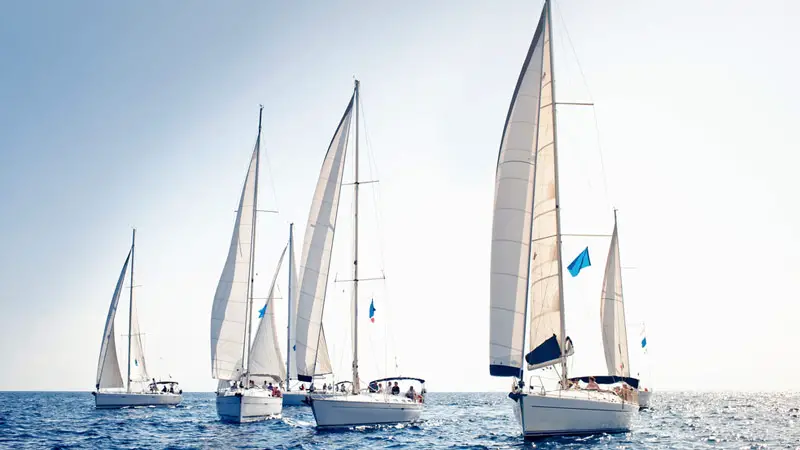
Sailboats hold a unique and enduring presence in marine traffic. They are characterized by their dependence on the wind for propulsion, using sails to catch and harness its power. These vessels, varying from small dinghies to large sailing yachts, offer a sense of tradition, adventure, and connection with nature that is often unmatched.
Sailboats can navigate in areas with depth restrictions where larger powerboats cannot go, and their silence and absence of emissions make them an eco-friendly choice for seafaring.
Despite their slower speeds and lesser maneuverability than powerboats, sailboats generally have the right of way under the COLREGs when they are under sail and in a crossing situation with power-driven vessels. This rule recognizes the limitations of a sailboat’s maneuverability due to its dependence on wind direction and strength.
However, this privilege does not free them from the responsibility of maintaining a proper lookout and taking corrective action when it’s clear that the give-way vessel isn’t taking appropriate action or when both vessels are in such proximity that immediate action is necessary. Therefore, the role of a sailboat in marine traffic is not just about leveraging wind power but also about understanding and adhering to the navigation rules for everyone’s safety.
The Powerboat-Sailboat Encounter: Identifying the Give-Way Vessel
Navigating encounters between powerboats and sailboats is a fundamental aspect of marine safety. In general, according to the International Regulations for Preventing Collisions at Sea (COLREGs), the powerboat is usually the give-way vessel when encountering a sailboat that is under sail. This is because a powerboat with an engine is typically more maneuverable than a sailboat that relies on the wind for propulsion.
The give-way vessel, in this case, the powerboat, has the responsibility to take early and substantial action to avoid colliding with the stand-on vessel, which in this case would be the sailboat. This may involve altering the course, reducing speed, or combining both. These rules aim to create a predictable path for both vessels to prevent a collision.
However, it’s essential to understand that these rules can have exceptions based on specific scenarios. For instance, when a sailboat overtakes a powerboat, it becomes the give-way vessel, regardless of its propulsion method. Furthermore, if the sailboat is operating its engine and not clearly showing sails, it is considered a powerboat under the COLREGs.
Both powerboat and sailboat operators must know these rules to ensure safe navigation. Importantly, the ultimate rule is to avoid collision – even if this means the stand-on vessel has to give way. Knowledge, caution, and mutual respect are key to maintaining safety on the water.
Factors Influencing the Give-Way Decision For Boats
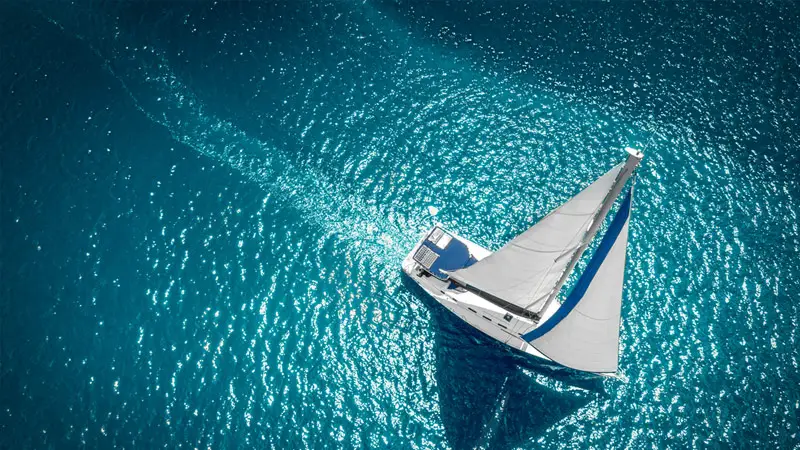
Several factors influence the decision of which vessel is the give-way vessel. These include the type of vessels involved, their relative positions, and the specific scenario they are in. While the general rule is that powerboats give way to sailboats under sail, there are exceptions and other factors that can change this rule. Understanding these factors is critical for safe navigation and collision avoidance.
Key factors influencing the give-way decision include:
- Type of Vessels Involved: The type of vessels involved in an encounter greatly influences the give-way decision. For example, vessels not under command, vessels limited in their ability to maneuver, boats constrained by their draft, fishing vessels, and sailboats generally have right of way over power-driven vessels.
- Relative Positions: The relative positions of the vessels also influence the giveaway decision. For example, a vessel overtaking another is generally the give-way vessel, regardless of the type of vessel involved.
- Operating Conditions of Vessels: Whether a vessel is under power or sail can influence the give-way decision. A sailboat under power is considered a power-driven vessel subject to the same rules as other vessels.
- Navigational Hazards: Navigational hazards may also impact the giveaway decision. A vessel in a position where it can safely navigate may be required to give way to a vessel closer to navigational hazards.
- Traffic Density: In areas of high traffic density, vessels may be required to maintain a higher level of vigilance and may need to take action to avoid collisions earlier than in areas of low traffic density.
Remember, while the give-way rules provide a framework for determining who has the right of way in a given situation, the ultimate responsibility of all mariners is to take whatever action is necessary to avoid a collision.
Special Situations: Exceptions to the Rule
While the general rules of navigation provide a solid foundation for maritime safety, there are special situations where exceptions to the rule apply. These exceptions account for the complexity and unpredictability of marine conditions and ensure that the primary goal of collision avoidance is always met.
- Overtaking Situations: Regardless of the type of vessel, the overtaking vessel is usually the give-way vessel. The stand-on vessel should maintain its course and speed, while the overtaking vessel should keep out of the way until it is past and clear.
- Narrow Channels: In narrow channels, all vessels should keep as near the channel’s outer limit on their starboard side. A boat shorter than 20 meters in length or a sailing vessel can not hinder the passage of a vessel that can navigate only in a narrow channel or fairway.
- Traffic Separation Schemes: In traffic separation schemes, a vessel should join or leave a traffic lane at the smallest angle to the general direction of traffic flow. A vessel should try to avoid crossing traffic lanes and should cross on a heading as close as possible to right angles to the prevailing traffic flow direction if obliged.
- Vessels Not Under Command or Restricted in their Ability to Maneuver: These vessels, due to exceptional circumstances, cannot maneuver as required by the COLREGs and are, therefore, usually given the right of way.
- Vessels Engaged in Fishing: Vessels engaged in fishing, when underway, shall have the right of way over other vessels, except those not under command or restricted in their ability to maneuver.
Bryan is a Las Vegas resident who loves spending his free time out on the water. Boating on Lake Mohave or Lake Havasu is his favorite way to unwind and escape the hustle and bustle of the city. More about Bryan.
Similar Posts
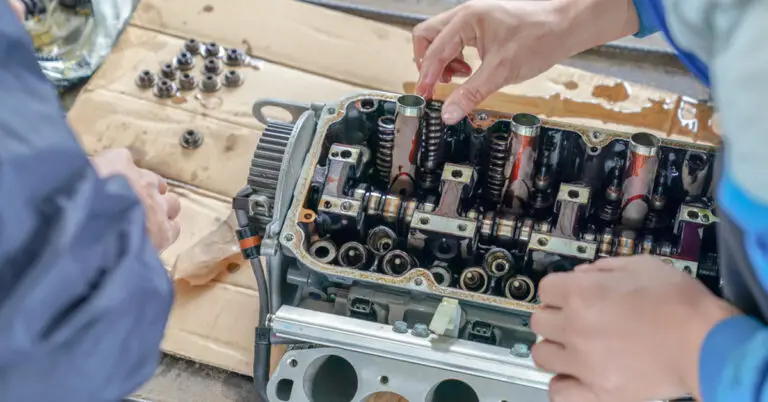
Boat Engine Submerged in Freshwater: Steps to Salvage and Prevent Damage
There’s something profoundly serene about the gentle bobbing of a boat on a tranquil freshwater lake. But the harmony is swiftly broken when the unexpected happens, such as your boat engine taking an unanticipated plunge beneath the surface. This article isn’t about the peaceful afternoons spent on the deck or the exhilarating moments of catching…

Can You Power Boat To Hawaii? (Factors to Consider)
From the west coast, Hawaii is approximately 2,500 miles away. Though no ferry boats operate on this route, there are a few cruise services, which can take you to the beautiful volcanic island chain. But what if you already have a boat and you’re wondering if you can power boat to Hawaii yourself? While it…
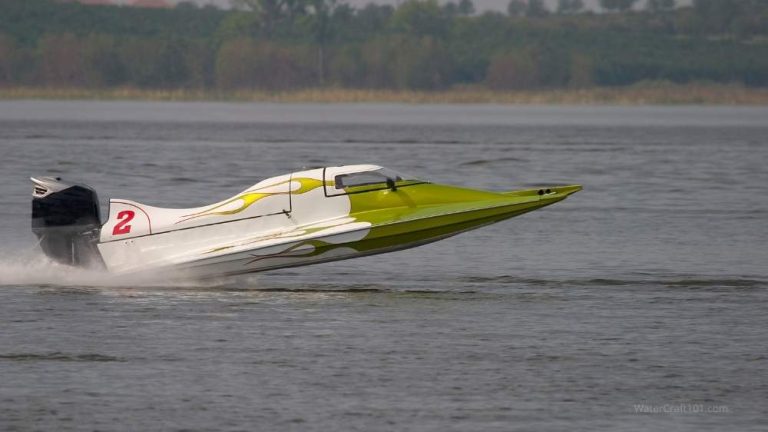
High-Speed Boating (What Is It & How Fast?)
While you may enjoy driving your boat fast as it will go, true high-speed boating takes boating and speed to a whole other level. But what are speed boats, and what is considered high-speed boating? High-speed boating uses a powerboat (a boat with a motor) to travel at speeds between 150 – 200mph or faster….
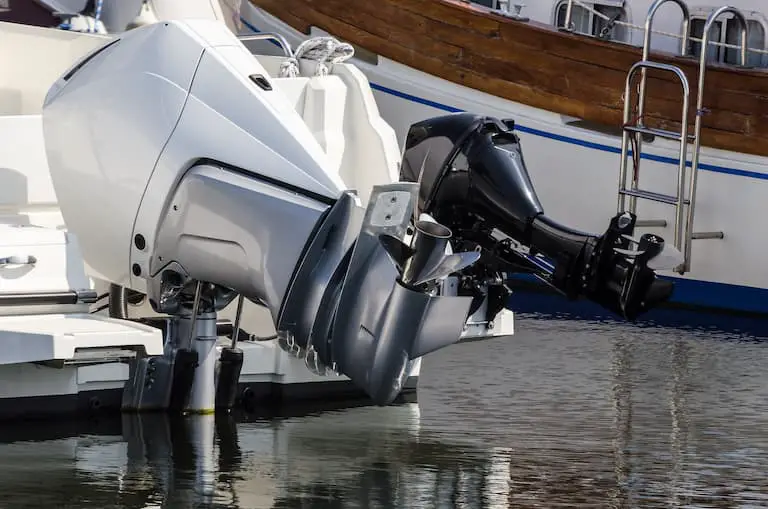
9 Common Reasons Why an Outboard Dies at Idle (Explained)
Outboard engines are a convenient and practical way of propelling your beloved boat through the water. However, like all engines, outboard engines are prone to specific issues. One problem that many boat owners come across is the outboard motor stalling while at idle. Here are 9 common reasons why an outboard dies at idle: Keep…
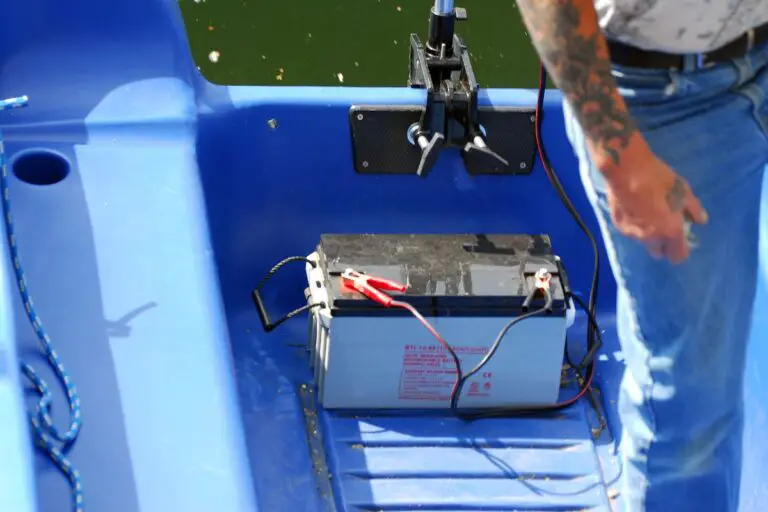
Why Does My Boat Battery Keep Dying? (Boating Batteries Explained)
Experiencing a dying boat battery can be both frustrating and perplexing, especially when it happens repeatedly. There are various reasons why your boat battery might keep dying, and understanding these causes is the first step in solving the issue and ensuring smooth sailing. The most common reason a boat battery keeps dying is due to…
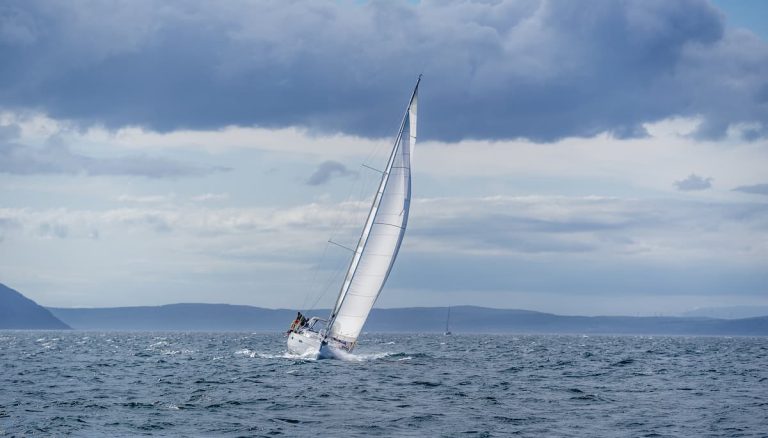
What To Do When a Sailboat Is Heeling Too Much (Explained)
Sailing is a fun activity for many people, but it comes with the innate prerequisite of being on the water rather than on stable ground. Aspiring captains must learn how to navigate and operate a boat while it rocks around in the water, which means dealing with things like heeling (i.e., leaning too far to…

The give-way hierarchy – sail boats and power boats
by Simon Jollands | Boat Handling , Crewing skills , Navigation , Yacht ownership

Who gives way to who at sea?
Even seasoned sailors sometimes get this wrong and in a crowded harbour this can easily lead to a collision or at best considerable embarrassment for a boat that mistakenly thinks it has right of way over another.
I recently went sailing with friends over a busy weekend on the South Coast of England. The conditions were perfect for sailing, a Force 4 breeze, full sunshine and everyone was out to enjoy themselves. While the conditions were perfect, Chichester Harbour was crowded with dinghy sailing races, keelboats, yachts, kayakers, paddle boarders, fishing vessels and countless motor boats of all sizes.
As we sailed towards the harbour entrance the crowding intensified and we kept a constant lookout in all directions. With a full genoa set, it was easy enough to keep a lookout to windward, but to leeward there is a significant blind spot for the person on the helm, so we decided to have a crew member at the bow to keep an all round lookout.
There was quite a bit of discussion about which vessels had right of way over others, so this has prompted me to produce a basic reminder of the give way hierarchy between sailing boats and power boats, plus explanations of what is meant by the give-way vessel, stand-on vessel and the overtaking rule.

The give-way hierarchy
- Power boat gives way to sailing boat.
- Sailing boat gives way to boat engaged in fishing.
- Boat engaged in fishing gives way to vessel with restricted ability to manoeuvre.
- Vessel with restricted ability to manoeuvre gives way to vessel not under command.
- Note: A sailing boat which is motor sailing does not have priority over a power boat, even if it has sails hoisted.

Sailing boat hierarchy
- Port tack gives way to starboard tack.
- If on the same tack, the windward boat gives way.
- If it is unclear to a sailing boat on port tack which tack another sailing boat to windward is on, then the boat on port tack must give way.
Power boat hierarchy
- If two power boats are heading towards each other, both boats should alter course to starboard, so their port sides will pass each other.
- If two power boats are crossing paths and there is a risk of collision, then the vessel which has the other on its starboard side must give way. It must also avoid crossing ahead of the stand-on boat.
- If a power boat meets another head on and is not quite sure if a collision is likely, then it should assume it does and alter course to starboard.

Give-way vessel
- When two similar vessels are crossing, the one that has the other to its starboard side is the give-way vessel.
- The ‘give-way’ boat is responsible for keeping clear and altering course where necessary to avoid a collision.
- The give-way boat should make an obvious course direction in plenty of time, so the stand-on vessel is in no doubt it has taken avoiding action.
Stand-on vessel
- If you are the stand-on boat, keep to your course and speed to make it easier for the give-way boat to manoeuvre out of your way.
- If the give-way vessel does not take avoiding action, the stand-on vessel must be ready to turn quickly out of the way or stop as a last resort.

- All vessels, whatever their size and type, must keep well clear of others when overtaking.
- It is courteous to overtake a sailing boat on their leeward side, so as not to take their wind.
- The vessel being overtaken must maintain its course and speed.
- The overtaking vessel must be well clear of the other before it can resume its original course, allowing the overtaken vessel to maintain its course throughout the manoeuvre.
A vessel is said to be overtaking another if it is approaching more than 22.5º behind the other vessel’s beam. This overtaking sector covers an arc of 135º, which is the same as the arc of a stern light. At night, it is easy to tell if you are overtaking a vessel because you can see its stern light as you approach it.
During the day, it is not always as easy to be sure you are in the overtaking sector. Are you overtaking or alternatively are you crossing the other vessel’s path, in which case you could have right of way? If in doubt, it is always best to proceed with caution and keep well clear of the other vessel.

- Keep a lookout at all times.
- Remember to follow the give-way hierarchy. Vessels with priority over you have the right of way.
- When altering course, make sure that the new course does not result in another close-quarters situation.
- Be prepared to reduce speed if you are the give-way boat.
Finally, in a very crowded harbour situation it is wise for sailing boats with engines to furl their sails and proceed under engine until they are clear of the harbour entrance. This is not a rule as such in most harbours but it makes sense and is what we decided to do until we had left the harbour.

Share on Facebook Share on Twitter Share on Linked In Share by Email
safe_skipper_apps

Recent Posts
- Navigating Through Rough Waters: Tips for Handling Adverse Weather Conditions in a Sailboat
- Docking a Motorboat
- Sailing Safely at Night – Best Practice
- Boating Etiquette: Do’s and Don’ts on the Water
- Navigating narrow channels
- About Sailonline
The One Source For Yacht Charters And Charter Yacht Ownership

- What is boat chartering
- Choose your best charter type
- Choose your charter company
- Choose a cruising area
- Choose the right boat
- Booking your charter
- Your sailing resume
- Yacht Charter Destinations Chart
- Catamarans vs. monohulls
- Bareboat Destination Skills
- Sailing Area Table
- Caribbean weather info
- What to pack for your charter
- Charter boat checklist
- Internet access on charter
- Briefing your charter crew
- Saving money on charter
- All boat charter tips in 1 file
- Budget Charter Fleets
- Provisioning a charter boat
- Booking directly with a boat owner
- The charter days you really get
- Managing your boat on charter
- Boat charter with kids
- Seasickness tips
- Starting a charter from the USVI
- If you damage a charter boat
- Flotilla charters
- Charter with a handicapped child
- Crewed yacht charter myths
- Organize a crewed charter
- Crewed charter tips
- Browse The Database
- Submit your Boat Listing
- Yacht Management Contract
- Buying a boat with a partner
- Bareboat vs. crewed yacht
- Charter Yacht Phase-out
- Phase-out punch list
- Yacht & Marine Surveyors
- Charter Boat Owners forum
- Yacht financial management tools
- 2nd tier fleets financial comparo
- Active ownership FAQ
- Layman guide to charter boat ownership
- Is Buying A Charter Boat For You?
- Buying a used charter boat
- Yacht buyer representation
- Bareboat vs. crewed yacht ownership
- Active Yacht Ownership
- Customers' Testimonials
- Cruising Logs
- Captain licenses
- 'Heaving to' maneuver: A must
- Charter Boat Seamanship Manual
- Yacht Crew Certification: All answers
- Snorkeling & kayaking safely
- Rules of the Road
- MOB Crash-Stop Maneuver
- 5 Knots you must know
- Flag Etiquette
- Emergencies on charter
- Distress calls at sea
- Navigation on a yacht charter
- Navigation aids sheets
- Estimate distances at sea
- Heavy weather basics
- Caribbean weather information
- VHF use: The basics
- Raising Main Sail | UnPC
- Anchoring technique & hand signals
- Catamaran sailing tips
- Docking: Avoid the embarrassment!
- Mooring technique
- Med-mooring technique
- Dinghy handling: make the best of it!
- Reefing a Catamaran
Remember Me
- Forgot your password?
- Forgot your username?
- Create an account
Boating Rules of the Road

Remember that other boat's crew that almost T-boned yours and then, having missed you by a few inches, waved hello at you, not even realizing they had not respected your right of way? Save yourself from, at worst, damage and, at best, from embarrassment. Read those basic Rules of the Road. They will cover most situations you will encounter in most charter areas. By the way, some rules are not real ones out of The Book, but just "play-it-safe" rules to stay out of harm's way (see Rules #1 and #2 for examples.)
Rules of Thumb
Rule #1: Boats that are much bigger than yours have the right of way, no matter what. Examples: Cargo freighters, cruise ships, big Caribbean inter-island ferries, garbage barges, etc... you get the idea. In theory, there are plenty of situations where those guys do not have the right of way. However, personally, when I see those big ferry boats coming straight at my boat, going full blast with no apparent intention of deviating from their course, I get out of the way. No questions asked.
Rule #2 : If you think the other boat's crew have not or cannot see you, just give way.
Rule #3 : If you have any doubt of any sort, get out of the way. Simple as that.
- Both boats on the same tack: the leeward boat has the right of way.
- Boats on opposite tacks: the boat on starboard tack has the right of way.
- Note (for the really challenged!): A sailboat is on the starboard tack when the boom is on the port side (or left side ). A sailboat is on the port tack when the boom is on the starboard side (or right side).
Read the real Rules of the Road
"Is that boat gonna ram into mine?"
How can you tell? Easy! (Method is valid regardless of the distance between the boats) . Say you see a boat seemingly coming towards yours at an angle, and you see it just forward of your starboard stay (If you have a hand compass, and you want to impress your neophyte crew, you can also take a bearing of the other boat.) Check again 2 to 3 minutes later. Three things can have happened:
The other boat is now much more forward of your starboard stay . In other words, the bearing of the other boat has moved forward . Result: If both boats maintain speed, the other boat will pass yours ahead of your bow. No risk of collision. If the boat is very far, re-check every 5 minutes.
The boat is now much more aft of your starboard stay . In other words, the bearing of the other boat has moved aft . Result: If both boats maintain speed, the other boat will pass yours behind of your stern. No risk of collision. If the boat is very far, re-check every 5 minutes.
The boat is still at the same spot relative to your starboard stay. In other words, the bearing of the other boat has not changed. Result: If both boats maintain speed and course, there is a risk of collision. In this case, assess which of you or the other boat has the right away. If it is you, keep the other boat in sight at all time; and if the other boat does not take unequivocal action to give way, then be ready to give way yourself. If the other boat has the ROW, take unequivocal action showing that you are giving the ROW. In any case, if at any time you feel that the situation becomes dangerous because the intention of the other boat is not clear, you must take evasive action. And that action must be clear and unequivocal to the other boat's crew.
That's it, folks. That's all you need to know for safe chartering!
Disclaimer : This article is for information only. Sailonline's and/or the author's responsibility cannot be engaged under any circumstances.
*Picture by Tom Lochhaas
- PREMIUM FILES
- Pre-Owned Yachts
- Charter Boat Owners/Buyers Forum
- Favorite Links
Most read articles
- Boat flag etiquette
- VHF Radio Basics
- Catamarans - Monohulls: Pros and Cons
- Charter Boat Ownership for Dummies
- Charter Boat Owners Group
Copyright ©2000 - 2022 Sailonline.com. Unauthorized reproduction prohibited. Sailonline is not affiliated with any charter company.

- AMERICA'S CUP
- CLASSIFIEDS
- NEWSLETTERS
- SUBMIT NEWS
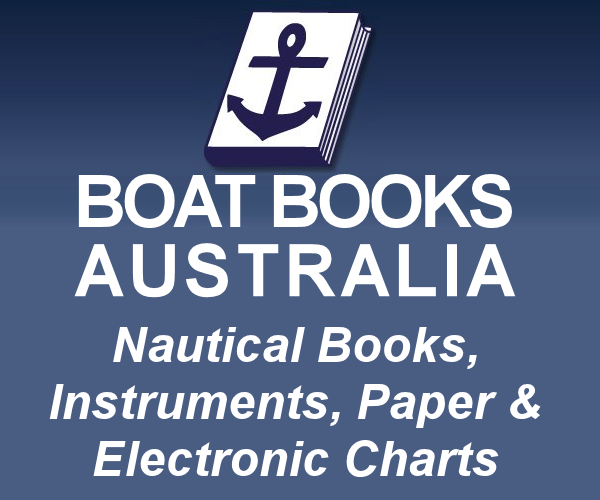
Right of Way and Who's Bigger
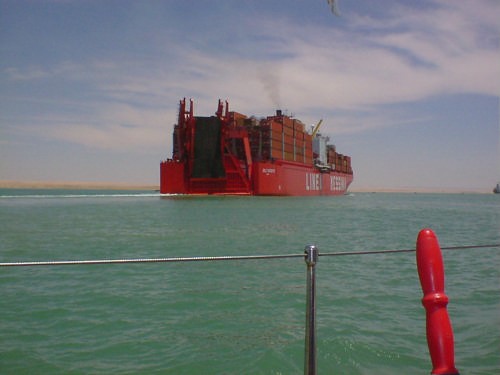
Related Articles
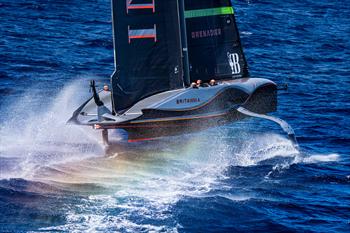

Right of Way Rules
Whenever two boats try to occupy the same water at the same time, a right of way situation exists. When this happens, one boat is obligated to give way to the other. The boat that is supposed to give way is Called the give way vessel and the other one is called the stand on vessel The stand on vessel should keep to its course so the skipper of the give way vessel can get out of the way without collision. There are specific rules to use in determining which vessel is which.
Motor vs. Sail : A motor boat is any vessel using an engine regardless of whether it is a sailboat or a motorboat. A sailboat is considered to be a motorboat even if the SailS are up as long as the engine is running. A sailboat that is sailing generally has the right of way over motorboats. But there are some exceptions.
- Large motor vessels are given the right of way in channels where it is difficult for them to maneuver. In the case of ships, the whole San Francisco Bay is considered to be channeled so that ships always have right of way in the Bay.
- In narrow channels such as Redwood Creek, motor vessels as small as 65 feet may be limited in maneuverability enough to make them the "stand on" vessel.
- Motor vessels that are restricted in maneuverability due to the special job they are doing are "stand on" This could be anything from towing nets to dredging, pile driving, or tending buoys.
- Motor vessels don't have to give way to sail boats that are motoring when the rules for motorboats give the motor vessel right of way. (When motoring, a sailboat is treated like any other motorboat.
- If a motor vessel is experiencing some kind of difficulty restricting its maneuverability, it is given right of way.
- If a sailboat is overtaking a power boat, the power boat has the right of way.
Passing - When any boat is passing another boat, the passing boat is tile give way boat and tile boat being passed is the stand on boat. Head On - When two motor boats approach each other head on, both boats turn to the right and pass each other port to port. Crossing - When motor boats paths cross, the boat on the other's right is stand on and the one on the other's left is the give way boat This is like two cars coming to a 4-way stop except that a give way boat would alter course to go behind the other boat Sailboats When encountering sailboats that are sailing, motorboats generally should give way. If you are motoring in a sailboat, you should give way to sailboats that are sailing.
- Log in to post comments
© 2022 Spinnaker-Sailing San Francisco. All Rights Reserved.


Sailboat vs Powerboat - Which is Right for You?

Sailboats and powerboats both have unique advantages and disadvantages. You have to weigh the pros and cons of each to know which boat is right for you.
Sailboats require a more hands-on approach, which many people prefer. Yet, powerboats have less maintenance and more speed. Which kind of boat you choose depends entirely on what kind of experience you want to have.
Powerboats are easier to operate, and they require a little experience. But, they are costly to keep running and you’re reliant on how much fuel you brought on board.
On the other hand, sailboats require training and experience. But, sailing is the purer boating experience, and many people prefer it because it offers them the freedom to travel anywhere in the world with only the wind.
Table of contents
Should You Get a Powerboat?
Powerboats are fast, fun, and spacious. For people who just want to get out on the water, without much setup, motorboats provide that easy access.
Depending on the boat, there are tons of family activities to do, such as tubing, waterskiing, wakeboarding, or fishing. Or, you can just enjoy a cruise around the waterways.
Powerboat Pros
Powerboats typically have more deck space because there isn’t as much hardware taking up space as in a sailboat. So, you can take out more people at a time, which is a pro for people with big families or who plan on taking many people out with them each time.
Often, the galley and cabin area has more space in a motorboat as well. People who plan on taking long off-shore fishing trips prefer motorboats because of the deck space for gear and people. Also, motorboats don’t have the same deep hull as a sailboat, so you can get into shallower waters if necessary.
If you’re new to boating, a powerboat might appeal to you more than a sailboat because there isn’t as much training involved in learning how to operate it. Sailboats take months (sometimes years) of experience to get confident with. With a motorboat, all you need is a GPS and a vessel license.
Also, to operate a motorboat, you’re only reliant on the sun shining. You don’t have to wait for wind conditions to be perfect. You can just get up and go whenever you feel like it. Unlike with sailing, where you are subject to changes in wind and tides.
Powerboat Cons
Even though powerboats are easier to operate and give you more space, they are more expensive to operate. You’re reliant on the engine to move, and you’ll likely use a lot of fuel each time you go out, which can quickly add up. Also, it’s less environmentally friendly than a sailboat, which uses minimal amounts of fuel.
The engines on powerboats are more expensive too. If for some reason you have to replace Or repair the engine on your boat, you can expect to pay a pretty penny. For that reason, it’s important to do regular check-ups and maintenance on your engine to keep it running smoothly.
The engine itself is also loud and smelly, which some people might say retracts from the experience of being out on the water. For people who get seasick especially, that smell doesn’t help.
Basically, with a powerboat, expect to pay more and have an experience that’s focused more on the water activity, rather than the joy of being on the water.
Should You Buy a Sailboat?
Sailing is one of the oldest methods of transportation, and that classic romantic feeling remains. With sailing, you have to pay attention to wind conditions, before you go out and as you’re on the water.
Sailboat Pros
Many people prefer sailing because it forces you to be in tune with the elements and the boat itself. Sailing is a very hands-on activity that requires training and practice to do effortlessly.
Because more effort goes into sailing, most people find it to be a rewarding experience that rejuvenates and refreshes the senses and the mind. You could compare operating a sailboat to doing yoga. All the pieces have to flow together, including the people on board.
Even small sailboats have trolling motors onboard. But, most sailors try to use the motor as little as possible and rely solely on the wind and tides. Not having a large engine saves you money on fuel and maintenance costs.
Sailing is much better for the environment than powerboats are. Sailing doesn't do any damage to the environment, as long as you stay off reefs and don’t allow trash to fall into the water. Motor usage is minimal, so you don’t contribute to the world’s fuel consumption as much. Many sailors pride themselves on being able to sail their boat without using the motor at all, even when it comes to docking.
Also, since sailboats rely on the wind, you can travel anywhere in the world if you want. There are countless accounts of people crossing oceans with only the wind in their sails.
Or, if sailing across the Atlantic isn’t for you, many people enjoy island hopping in the Caribbean for months at a time. If that appeals to you, you might be a sailor.
Unlike with a motorboat, you can go virtually anywhere on a sailboat with a bit of weather planning and manpower, no fuel necessary.
Sailing is a more satisfying experience and a quieter one as well. Since wind powers a sailboat, there’s no engine noise or smell to hinder your experience.
Some might say sailboats are for those people who are more adventurous at heart.
Sailboat Cons
Even though some people enjoy the hands-on aspect of sailing, it does require training. It’s dangerous to operate a sailboat on open water without proper knowledge of its workings.
Sailboats have a lot of moving parts and hardware. Many people grow up sailing and get their experience that way. But, if you aren’t someone who grew up sailing, you should consider a sailing class or even asking an experienced sailor to take you out and teach you what they know.
If you’re someone who doesn’t want to take the time to learn how to sail , it might not be the right boat for you.
Then, there’s the fact that you’re reliant on the right conditions for sailing. If there’s no wind or too much wind, your sailing experience won’t be as enjoyable or even possible. If you live somewhere that doesn’t have regularly good sailing conditions, that might prove to be a major con for you.
Or, if you don’t have a schedule that allows you to go sailing whenever the conditions are right (which could be in the middle of the week), you might not get as much sailing time out of your sailboat as you’d like.
There is no quick outing on a sailboat. It requires planning with the weather and tides, setting up the rigging and sails, and being at the mercy of the wind. So, if you don’t want your outing to take up most of the day, sailing might not be for you.
Because sailboats have deeper hulls, you have to be careful of shallow areas. It is possible to get stuck with a sailboat.
Also, many people choose to keep their sailboat in a slip at a marina because anything over 20’ is more difficult to transport and store. With a deck slip, you can keep the mast up and the rigging ready to go, so there’s less set up a time when you do want to go out.
So, if you’re in the market for a sailboat, make sure to check the cost of local dock slips as well and decide if that’s in your budget.
Because of the sails, mast, and rigging, you have less deck space with a sailboat. To get the deck space you desire, you’ll likely have to counter with a larger sailboat.
Finally, sailing is more of a commitment than a powerboat, but it’s a more rewarding experience that boating purists deem worth it.
Sailboat vs Powerboat: Which is Right for You?
There’s a lot to consider when it comes to deciding on a sailboat or a powerboat. Ultimately, it comes down to what kind of boating experience you’re looking for, and how much time you’re willing to commit to it.
Motorboats are a hobby, while sailboats are more of a lifestyle.
If you want to get out on the water without much fuss on choice weekends with your friends and family, a powerboat will get you out there. But, expect to pay high fuel prices and sacrifice some of the experience of being on the water.
On the other hand, if you’re looking for a way to get closer to nature, yourself, and possibly explore the world, a sailboat is the vessel for you. A sailboat requires more training to operate, more time to plan trips, and often you get fewer amenities with it.
Despite that, sailing is a purer boating experience that forces you to focus on the task at hand and the elements around you. If you plan to sail with your family or friends, it’ll be a bonding experience for everyone involved.
Related Articles
Daniel Wade
I've personally had thousands of questions about sailing and sailboats over the years. As I learn and experience sailing, and the community, I share the answers that work and make sense to me, here on Life of Sailing.
by this author
Most Recent

What Does "Sailing By The Lee" Mean?
October 3, 2023

The Best Sailing Schools And Programs: Reviews & Ratings
September 26, 2023
Important Legal Info
Lifeofsailing.com is a participant in the Amazon Services LLC Associates Program, an affiliate advertising program designed to provide a means for sites to earn advertising fees by advertising and linking to Amazon. This site also participates in other affiliate programs and is compensated for referring traffic and business to these companies.
Similar Posts

How To Choose The Right Sailing Instructor
August 16, 2023

Everything You Can Pull Behind A Boat
May 25, 2023

Cost To Sail Around The World
May 16, 2023
Popular Posts

Best Liveaboard Catamaran Sailboats
December 28, 2023

Can a Novice Sail Around the World?
Elizabeth O'Malley
June 15, 2022

4 Best Electric Outboard Motors

How Long Did It Take The Vikings To Sail To England?

10 Best Sailboat Brands (And Why)
December 20, 2023

7 Best Places To Liveaboard A Sailboat
Get the best sailing content.
Top Rated Posts
© 2024 Life of Sailing Email: [email protected] Address: 11816 Inwood Rd #3024 Dallas, TX 75244 Disclaimer Privacy Policy
Understanding Boating Right of Way Rules
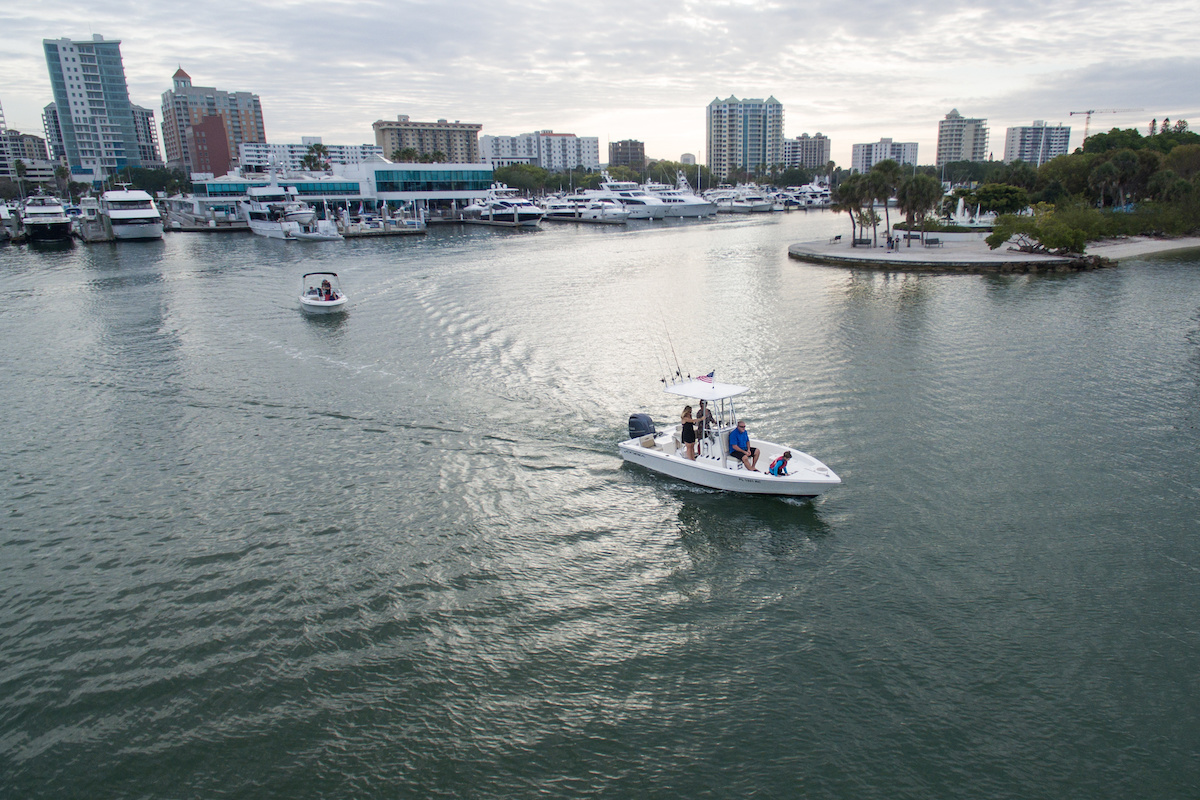
Since there are no yellow or white lines or stop signs on bodies of water, it can be difficult to understand who has the right of way in boating. Right of way rules (often referenced as the "rules of the road" or navigation rules ) are specifically defined maneuvering regulations designed primarily to avoid a collision between vessels. There are many rules and they differ by type of vessel, the operations that vessel is involved in at the time, and where the vessel is located (on inland or offshore waters).
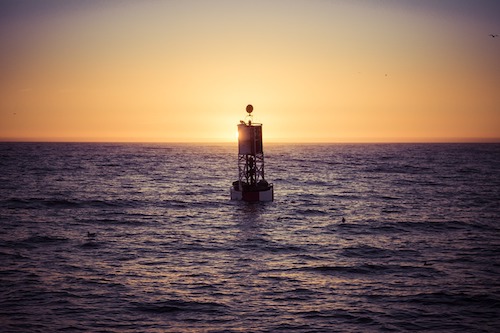
Learning and memorizing all of them is a tall order for boaters of all experience levels, but it’s imperative to know the basics and then have the proper reference tools aboard to consult for all the more nuanced regulations.

5 Boating Right of Way Basics
- Vessels under sail (without auxiliary power engaged) have right of way over powerboats in most cases. There are exceptions as described above and in an overtaking situation.
- When crossing, the boat on the right (approaching from starboard) has the right of way. At night, you’ll see a red light moving across your horizon to the left. If there is a constant speed and bearing, you’re on a collision course and need to take evasive action.
- When meeting head-on, each vessel must alter course to starboard if possible to give a wide berth to the oncoming vessel. At night you’ll initially see both red and green lights.
- Any vessel overtaking another must keep clear of the stand-on vessel. You must keep clear if you’re coming up from behind and passing any vessel even if you are under sail and are coming up on a powered vessel. At night you’ll see a white light.
- When approaching another vessel whose intentions aren’t clear, take evasive actions early and make them clear in order to communicate effectively with the other vessel. In other words, slow down and make any course changes large enough to be understood and consistent (don’t drive haphazardly).
Boating Etiquette: Reading Between "The Rules"
Sailing Right of Way
When two boats that are both under sail meet, the following rules apply:
- The boat on a starboard tack has the right of way—the wind coming over the starboard rail.
- When two vessels are on the same tack (the wind is coming from the same side), the leeward boat (downwind) has the right of way over the windward boat (that presumably has clean air for better sailing conditions).
- When on the same tack in a passing situation, the vessel being overtaken has the right of way—always.
It’s your responsibility as the captain to know the basics and to act in a responsible manner to avoid a collision even if you’re the stand-on vessel. Slow down, evaluate the situation, make your intentions clear and in the end, presume the other guy has no clue and avoid an accident.
For a complete listing of navigation rules, refer to “Navigation Rules of the Road” published by the U.S. Coast Guard (COMDTINST 16672.2 Series), available through the U.S. Government printing office and also available here online .
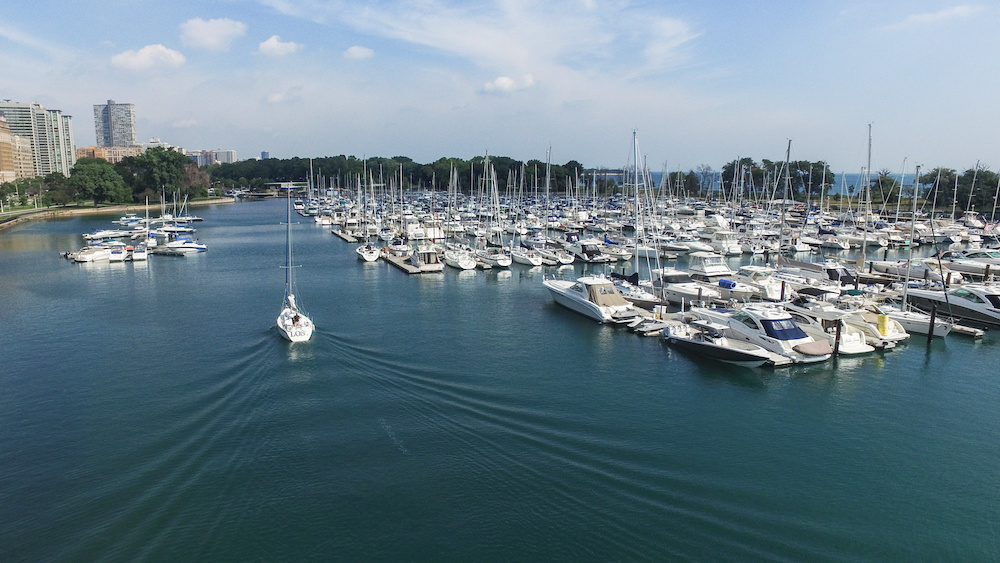
Vessel Types, Categories & Definitions
Navigation rules focus on how and where vessels move. These are also supplemented by light and sound signaling rules that are covered under different sections of what is called COLREGS, the International Regulations for Prevention of Collision at Sea, and they govern the responsibilities of vessel operators in inland and international waters. A copy of the Rules of the Road can be purchased at chandleries and a must be carried aboard vessels of 40 feet or longer.
The type of vessel will often dictate a captain’s course of action. Powerboats are propelled by machinery. Sailboats under sail are in one category but a sailboat with its auxiliary motor turned on and in gear is considered to be a powerboat even if its sails are up. The following vessels also have priority in certain cases:
- Vessels constrained by draft (boats with a deep draft moving through shallow channels).
- Vessels restricted in their ability to maneuver (boats that may be too large to be agile in a small body of water or those actively operating as tugs, buoy tenders, or those engaged in commercial fishing with gear deployed, etc.).
- Vessels not under command (no one is in charge for whatever reason).
Vessel circumstances are defined differently. A stand-on vessel has the right of way and must maintain course and speed. It must also acknowledge understanding the intentions of the give-way vessel if signaled. The give-way or “burdened” vessel has the responsibility to maneuver safely around the stand-on vessel.
Marine Navigation: How to Navigate a Boat
Frequently Asked Questions
Q. If I’m towing a wakeboarder and another boat that’s not towing is in my way, who has the right of way?
If you’re towing on a lake or river, inland rules of the road still apply. However, your priority should be the safety of both vessels and the person you’re towing so if you must take evasive action, signal your boarder and stop, slow down or turn to avoid an accident.
Q. My boat is only 20 feet long. Do I still need to have a copy of the U.S. Coast Guard Navigation Rules onboard?
You don’t need a copy onboard, but you do need to know the basics. If you’re hazy on any part, a copy may be a good investment.
Read Next: 5 Best Marine Navigation Apps for Boaters
You Might Also Like:
- Marine GPS for Boats: Understanding the Basics
- 5 Tips for Understanding Nautical Flags & their Meanings
- Night Boating Tips
- How to Tie Up a Boat: Mooring Guide
- Find the Right Boat for Your Lifestyle
Join Our Newsletter!
Get community news, buying bargains, and how-to guides at your fingertips.

How To Avoid Collisions While Sailing
Sailing rules of the road when sailboat meets sailboat.
There are only three basic possibilities, and three basic boating rules of the road to follow, when your sailboat approaches another sailboat.
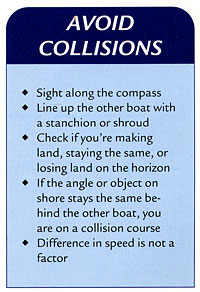
Rule 2: When you are on opposite tacks, the starboard tack boat has the right-of-way.
Rule 3: If you are overtaking the other boat, or it is overtaking you, the boat ahead (the overtaken boat) has the right-of-way.
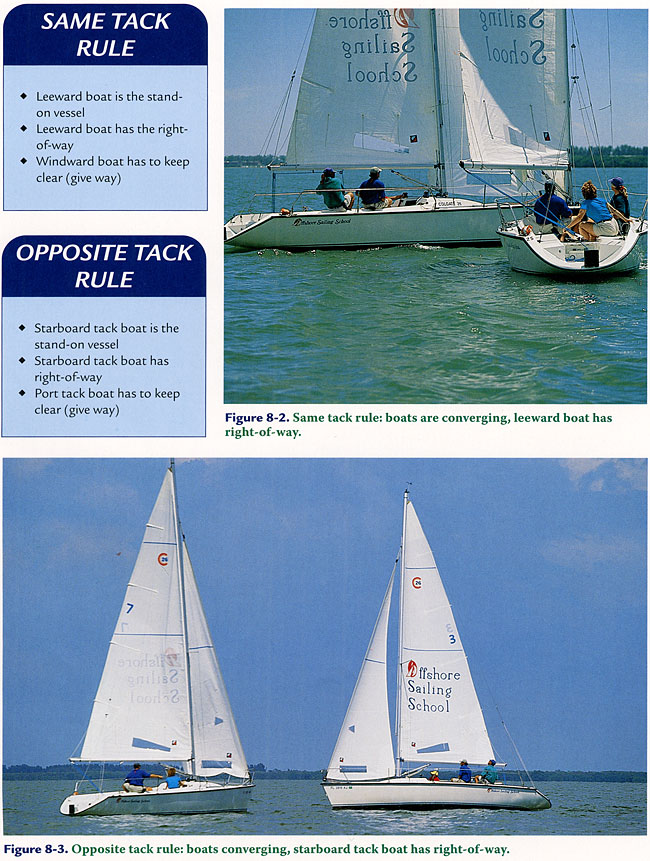
Figure 8-3 shows the opposite tack rule. The starboard tack boat is the stand-on vessel and has the boating right-of-way. The port tack boat has to keep clear or give way. Which boat is on port tack? If you said the boat on the right, you are correct.
Figure 8-4 shows two boats involved in the overtaking rule. In this case the boat ahead is the stand-on vessel and has the boating right-of-way. The overtaking boat has to keep clear or give way. Which boat is overtaking and what tack is that boat on? If you said the boat behind is overtaking and is on starboard tack, you are correct.
Note that these boats are sailing downwind, with the wind pushing from behind, and they are on opposite tacks. In the overtaking rule, the difference in tacks is not relevant, unless you are racing. Over many years, a complete set of sailing rules of the road specifically for sailboat racing has been developed and administered by the International Sailing Federation (ISAF), but these are not relevant to recreational sailing. If you’re looking to become a pro sailor, check out our Offshore Sailing Certification Courses.
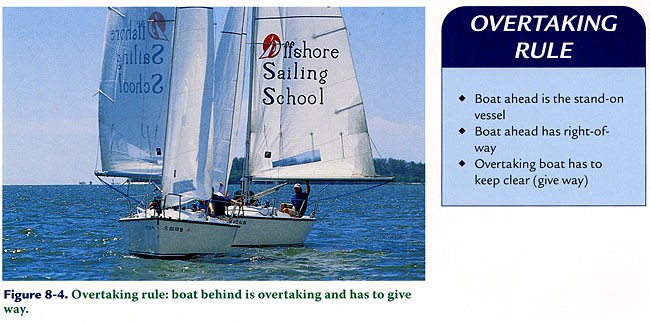
- Doris Colgate
Previous Post Changing Course Downwind
Next post interview with an offshore sailing grad.
Comments are closed.

6338 Presidential Court, #201 Fort Myers, Florida 33919
SPECIALS COURSES
LOCATIONS CONTACT US
ABOUT US SAILING TIPS
[email protected] Site Map Privacy Policy
© 2024 Offshore Sailing School - Official Site. OffshoreSailing.com is managed by Offshore Sailing School.
- Privacy Policy
- Fast Track to Sailing | Beginner to Advanced in Six Days
- Learn to Sail Certification Courses
- Family Learn to Sail Programs
- Sailing Lessons and Sailing Rides
- Small Sailboat Cruising Course
- Online Learn to Sail Course
- Fast Track to Monohull Cruising
- Fast Track to Catamaran Cruising
- Live Aboard Cruising Courses
- Bareboat Charter Courses
- Fast Track to Boat Handling & Docking
- Ultimate Cruising Course
- Boat Handling & Docking
- Navigation Courses
- Performance Sailing Courses
- Fast Track to Sailboat Racing Courses
- Performance Racing Clinics
- Coastal Passage Making Courses
- Offshore Passage Making Courses
- Celestial Navigation Courses
- Coastal Navigation
- Powerboat Courses
- Private Courses
- Docking Refresher Course on a Catamaran or Monohull
- Catamaran Refresher & 114 Endorsement
- IPC Prep With Cruising Certification & Catamaran Endorsement
- Team Building Programs
- Women’s Sail Sip Spa Week in the British Virgin Islands
- Top 10 Tips Learning How to Sail
- Safety and Comfort Aboard
- Sails & Sail Trim
- Steering and Maneuvering
- Handling Spinnakers
- Engine Maintenance
- How to Become a Sailing Instructor
- How to Choose a Sailing School
- Yacht Lease Management Opportunities
- Bookstore New!
- About Sailing
- Cape Coral Marina Village
- Fort Myers Beach
- St. Petersburg
- Captiva Island
- Scrub Island
- St. Lucia & Windward Islands
- Greece Ionian Islands
- Sicily In The Aeolian Islands
- Dubrovnik-Montenegro Flotilla Cruise
- Italy’s Amalfi Coast Flotilla
- Tahiti’s Society Islands
- Team Building
- Testimonials
- SAILING TIPS
- SPECIAL EVENTS
- Offshore Sailing School Returns to Captiva Island, Florida
- Sailing – Out & About SWFL
- America’s Cup Endeavor Program Videos
- Growing Up Moorings
- Doris Colgate Sailing Clinic & Cup
- Steve Colgate Inducted Into National Sailing Hall of Fame
- OSS Student Proposes During Course
- Steve Colgate and National Sailing Hall of Fame
- St. Lucia and Windward Islands Flotilla Cruise
- Weathering Unexpected Bad Weather
- A Sailing Adventure He Still Can’t Believe Was Real
- 2016 Croatia Flotilla Cruise Diary
- Colgate 26 LP
- How We Teach
- Steve & Doris Colgate
- Steve Colgate
- Management Team
- Employment Opportunities
- Our Mission
- Our History
- Alumni Benefits
- Awards & Accolades
- Our Philanthropy
- Certification Levels
- GET STARTED
- 2024 BOAT BUYERS GUIDE
- Email Newsletters
- Boat of the Year
- 2024 Freshwater Boat and Gear Buyers Guide
- 2024 Boat Buyers Guide
- 2024 Water Sports Boat Buyers Guide
- 2024 Pontoon Boat Buyers Guide
- Cruising Boats
- Pontoon Boats
- Fishing Boats
- Personal Watercraft
- Water Sports
- Boat Walkthroughs
- What To Look For
- Watersports Favorites Spring 2022
- Boating Lab
- Boating Safety
- Ultimate Boating Giveaway

Right-of-Way Rules for Boaters
- By Jeff Hemmel
- April 20, 2022
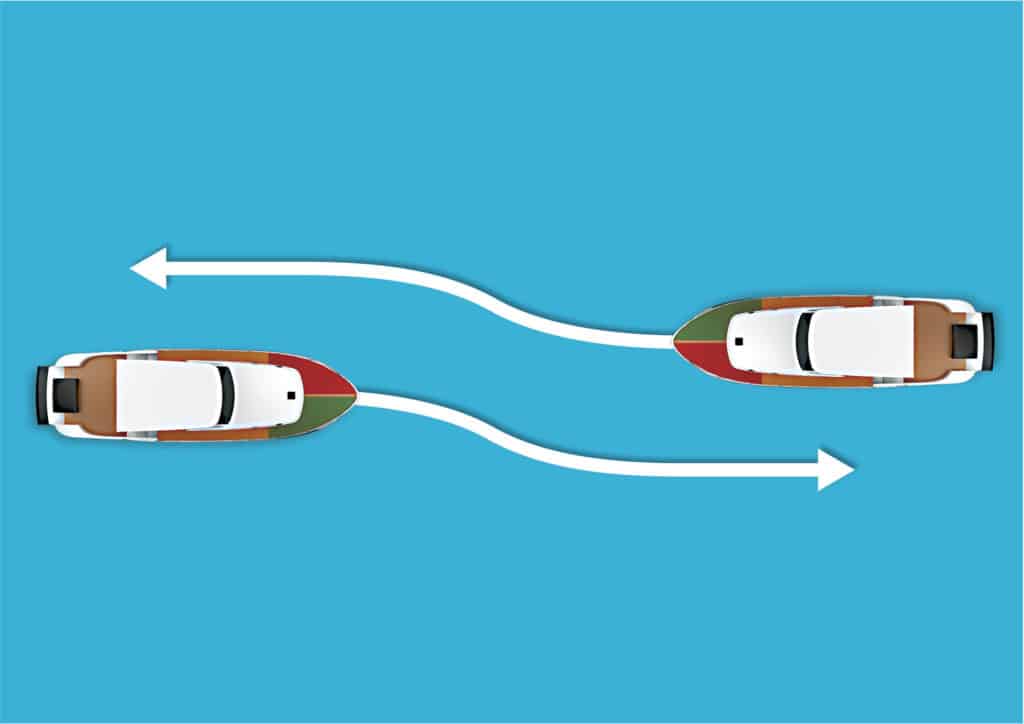
There is no right of way on the water. Every boater is obligated to do what is required to avoid collision. In any meeting of boats, one is deemed the stand-on vessel and the other the give-way vessel. The rules of the road explain the situation more completely and can be learned in a boating safety course. This article serves as a refresher and a reminder on how to handle some common meeting scenarios.
While more common in a channel or narrow pass, head-to-head meetings can happen anywhere on the water. When encountering an oncoming boat head-on, the rule is simple: Each boat is a give-way or burdened vessel and should stay to its right, altering course to starboard and allowing each craft to pass to the port (left) side of the other boat.
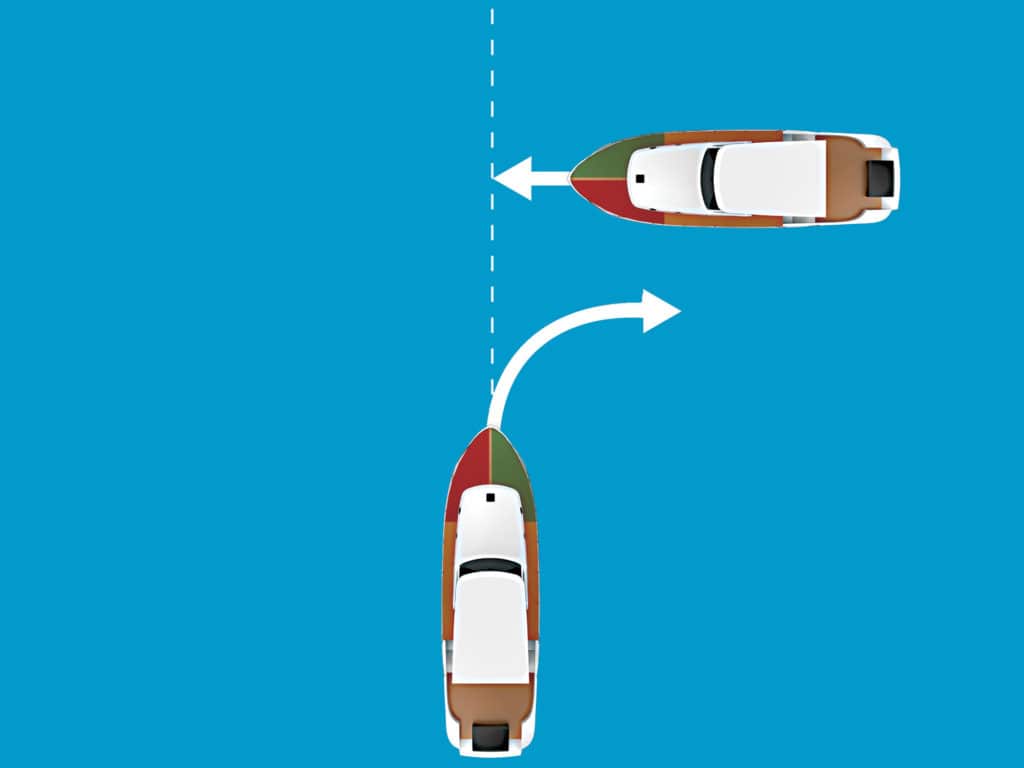
If the other boat is to your starboard (right), it’s considered the stand-on or privileged vessel and is obligated to maintain course and speed. Your boat is the give-way vessel and is obligated to slow or alter course to pass behind it, ideally. If the boat intersecting your path is to port (left), it’s the give-way vessel. It’s obligated to yield while you’re obligated to maintain course and speed.
When overtaking another boat, keep in mind that the other boat is the stand-on vessel and yours is the give-way vessel. Your first move? Determine to which side of that craft is the safest to pass. Consider oncoming traffic, waterway markers, obstacles, or even bends in the channel. Once you have a clear path with good forward visibility, increase your speed enough so that you can safely overtake the other vessel, giving the craft a wide berth.
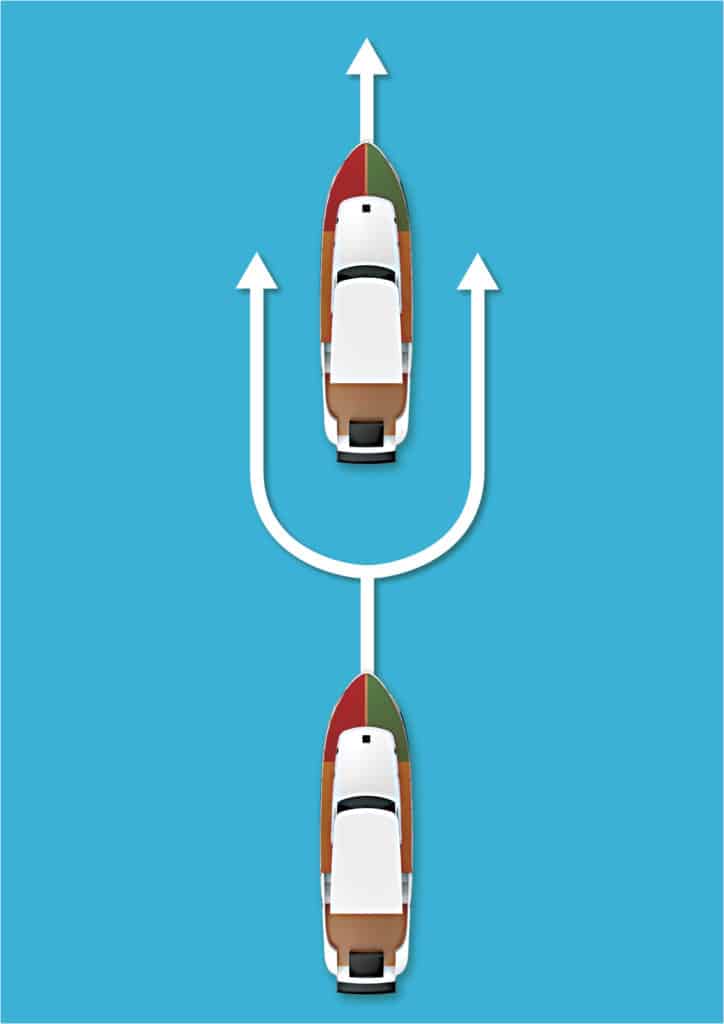
Encountering Kayaks, Sailboats, Etc.
Some vessels will almost always be the stand-on boat, and you must yield no matter the scenario, unless doing so will create an unsafe situation. Typically, this list includes paddlecraft and sailboats not under power, but it also includes larger craft, like ships or freighters. Realize these craft are not as maneuverable as most powerboats and, as such, the powerboat is deemed the give-way vessel.
Read Next: Boating Navigation Basics
When the Other Guy Doesn’t Know the Rules
No matter if you are the stand-on or give-way vessel, always be prepared in case the other boater doesn’t respond as you expect. Operate defensively, and be ready to yield, slow speed or change course to avoid any potentially dangerous situation. A good tip? Give other boaters plenty of space—100 feet or more—to allow enough time and distance to properly react and avoid an accident.
Know Your Colors
Do you know how to handle these scenarios at night, when you can’t see another boat, let alone determine its direction? Know your colors. Boats are required to display a green light to starboard (right) and a red light to port (left) at their bow, and most boats must display a single all-around white light at the stern. This combination of lights will help you determine which direction a boat is moving and if it’s likely to cross your path.
- More: Boating Safety , How-To , May 2022 , Seamanship
More How To

Compounding Mistakes Make for a Dangerous Situation

On Board With: Monique Richter
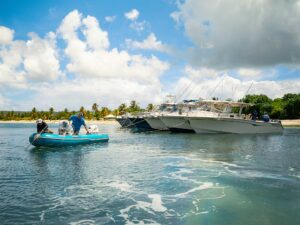
Grady-White Pulls off Its Largest Raft-up Ever in Vieques, Puerto Rico
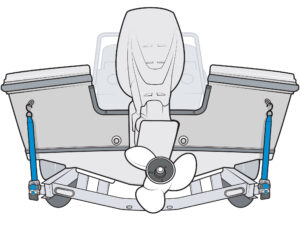
Installing Retractable Transom Straps
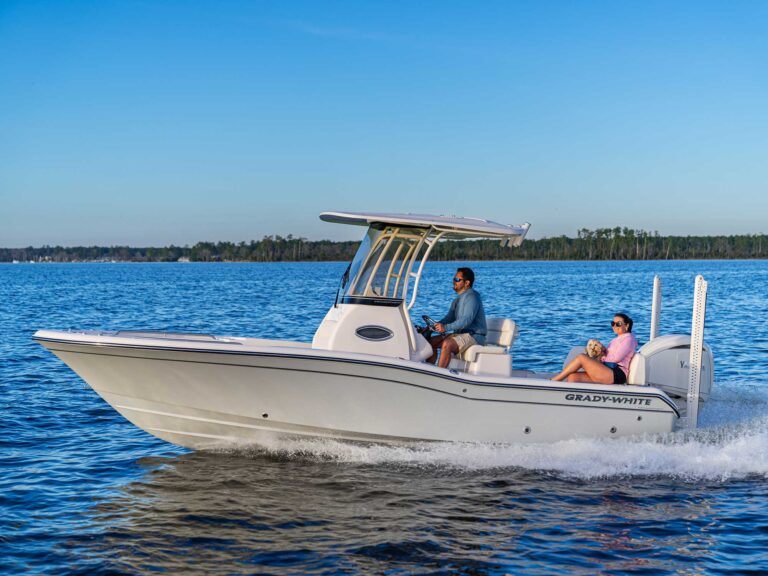
Boat Test: 2024 Grady-White 231 Coastal Explorer
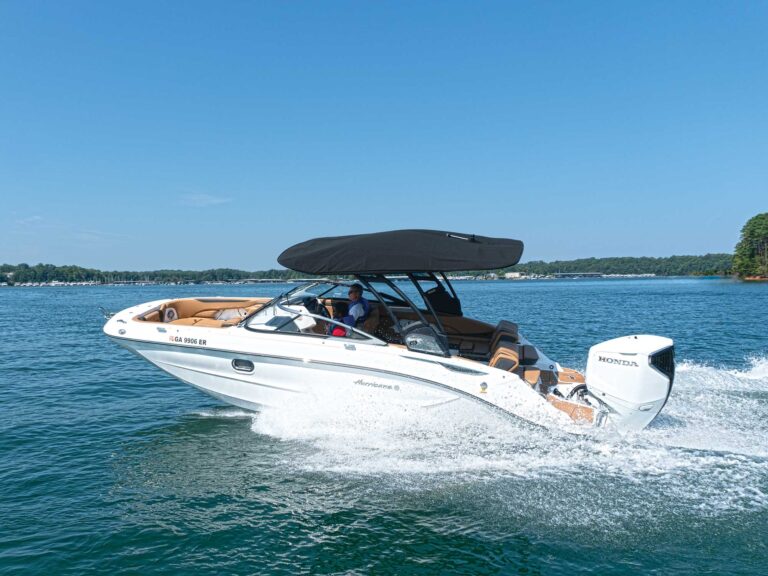
Boat Test: 2024 Hurricane SunDeck 2600 OB
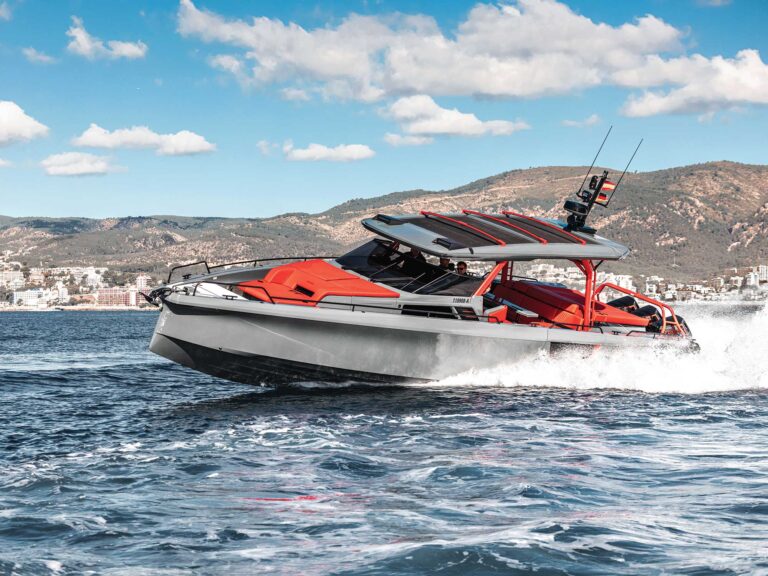
Boat Test: 2024 Brabus Shadow 1200 Sun-Top
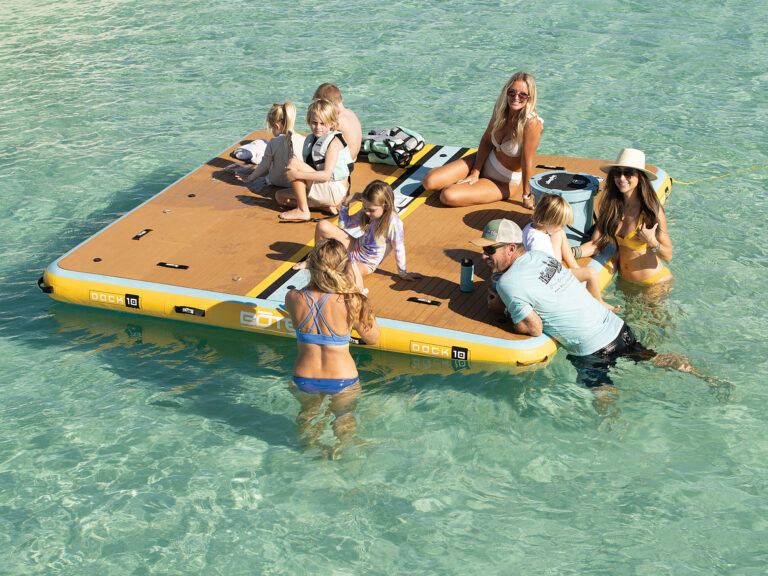
Inflatable Water Mats for Boaters

- Digital Edition
- Customer Service
- Privacy Policy
- Terms of Use
- Cruising World
- Sailing World
- Salt Water Sportsman
- Sport Fishing
- Wakeboarding
Many products featured on this site were editorially chosen. Boating may receive financial compensation for products purchased through this site.
Copyright © 2024 Boating Firecrown . All rights reserved. Reproduction in whole or in part without permission is prohibited.
- Build A Boat
- Find A Dealer

- Right of Way Rules for Boating
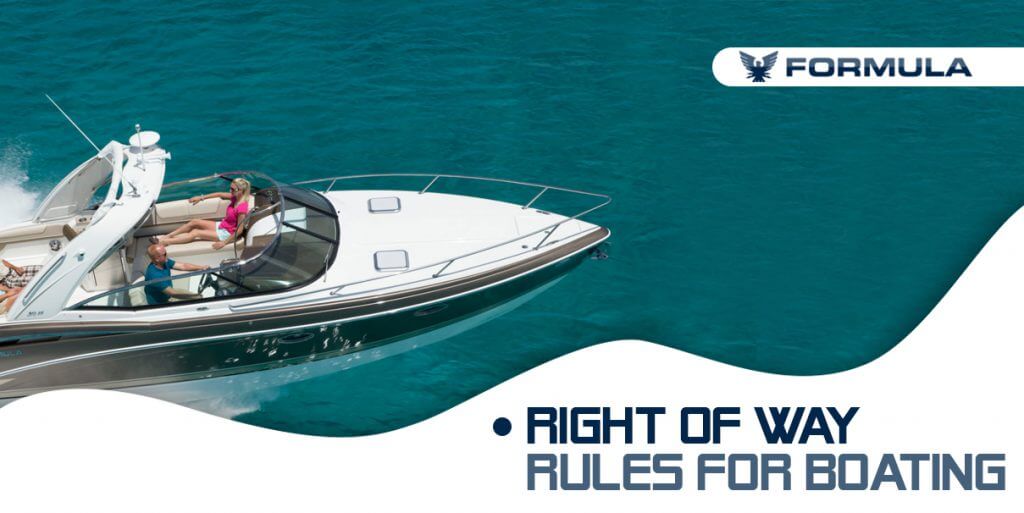
If you’re a new boat owner or you need a refresher on the right of way rules for boating — this article is for you.
While we all love to have fun on the water, safety is always the priority . You may be intimidated thinking about driving your new boat down a crowded waterway with all different types of vessels crossing your path. How does everyone know where to go and how to stay out of each other’s way? Fortunately, there are regulations to minimize collisions and to maintain order and safety. However, it is also important to note that despite the rules, it is always your responsibility to avoid a collision, no matter the scenario.
Every good captain must know the right way to approach interactions with other boats — just like how it’s essential to know traffic rules when driving a car. When you understand the fundamental boating right of way rules for rivers, oceans and harbors, you’ll be able to cruise through the most crowded waterways with ease. Let’s dive in.
The Importance of Knowing Boating Right of Way Rules
The United States Coast Guard reported almost 4,300 recreational boat accidents in 2017 . Surprisingly, most recreational boaters aren’t familiar with the boat right of way rules, which causes confusion and makes their boating experience less safe and more stressful. If you master even the basic principles of boat-passing rules, you’ll know how to behave in any situation and keep your cool.
As the captain of your vessel, it’s your responsibility to maintain the safety of your boat and everyone onboard. The more knowledgeable you are about how to do that — such as by knowing and understanding boating right-of-way-rules and collision regulations — the less you have to worry about something going wrong.
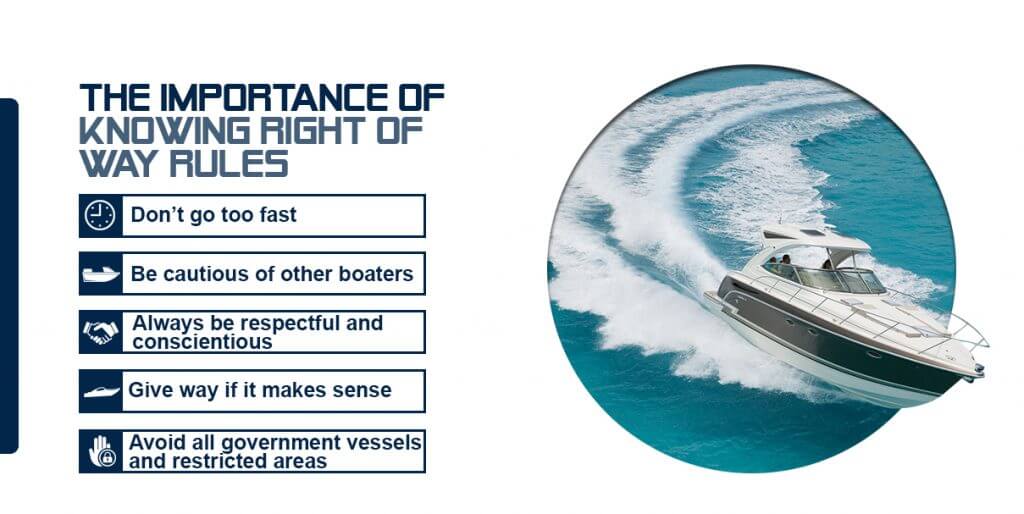
First things first — a few general tips and boating rules for maintaining navigational safety:
Don’t Go Too Fast
If you can increase the overall safety of your vessel or a vessel nearby by slowing down, you should. Sometimes the conditions are right to go fast, and sometimes they aren’t. It’s the job of a good skipper to know the difference. Take into account how many other boats are around you and if you have the proper space to slow down quickly.
Be Cautious of Other Boaters
Just like when you’re driving a car, just because the rules of the road exist, it doesn’t mean everyone follows them. Recreational boaters are notorious for not following the rules. If their actions seem unsafe, keep enough distance between you and them so that any unexpected maneuver won’t catch you off guard.
Always Be Respectful and Conscientious
While sometimes you may be operating under legal conditions, it’s still nice to give other boaters the respect and the space they deserve. Just because you have the right of way doesn’t mean you have to take it every time.
Avoid All Government Vessels and Restricted Areas
These vessels and areas almost always have the right of way, and it’s best to give them plenty of space.
Give Way If It Makes Sense
Even if you have the right of way in a situation that could be dangerous, it’s your responsibility to alter your course if it means avoiding an accident. If you did not change your course and an accident occurred, it’s possible you could still be at least partially at fault even if you did have the right of way. Safety always takes precedence.
Rules for Different Boating Scenarios
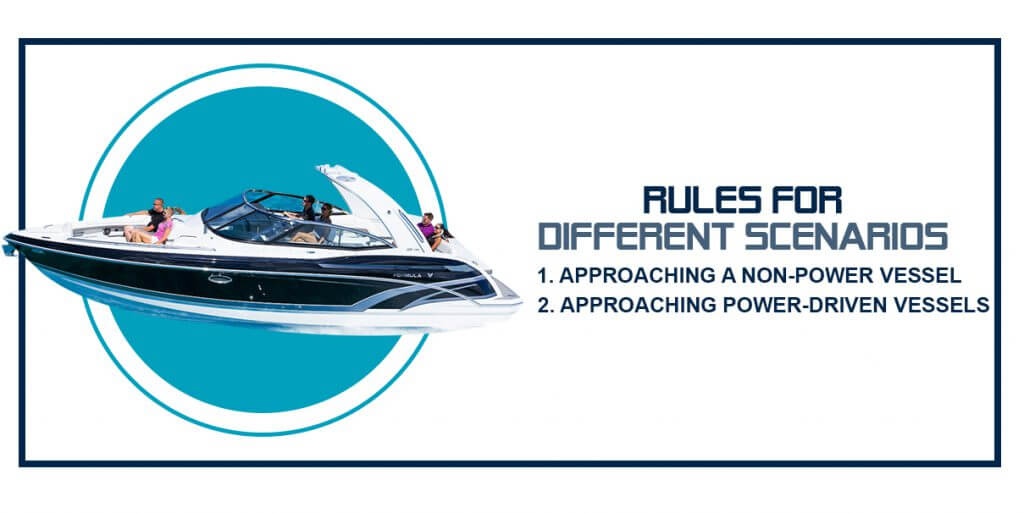
How two boats approach each other determines which has the right of way. Position, direction and the different levels of priority for different vessels make up the majority of the rules on the water. We’ll get into the different types of vessel priority a little later.
When a vessel has the right of way, they’re called the “stand-on” or “burdened” vessel . If you’re the stand-on vessel, you have to confirm the actions of the give-way vessel by maintaining your course and speed until you pass them or need to alter your course.
The “stand-off” or “give-way” vessel is the one that doesn’t have the right of way.
What does it mean to give another vessel right of way? You must ensure they can hold their current course and speed, which may mean substantially altering your course in a way that’s clear to the stand-on vessel.
For this article, we’re assuming you operate a power-driven vessel — the rules are a little more complicated if you’re sailing.
Here are some common scenarios you’re likely to encounter on the water:
1. Approaching a Non-Power Vessel
When you’re approaching a vessel without motor power, such as a sailboat, they have the right of way.
An important note — a sailboat must be “under sail” to qualify for the right of way over power-driven vessels. If they’re using their small outboard motor instead, they have the same right of way as a normal powerboat .
In recent years we have seen a proliferation of human-powered craft in the form of kayaks and paddle boards. The Navigation Rules refer to human-powered craft as “vessels under oars” and they are singled out only in the lighting rules. Otherwise they are simply “vessels.” We may encounter these vessels in three different navigational situations. We may encounter them in overtaking situations. The vessel being overtaken is the most privileged vessel on the high seas. Give that human-powered craft a wide birth when overtaking, being mindful of your wake as you do. The two other navigational situations in which we may encounter paddlers are head-on and crossing situations.
Interestingly, the rules don’t make specific provisions for power-driven vessels encountering vessels under oars in head-on and crossing scenarios. Rule 2 is the “responsibility” rule, and it, in essence, tells us to use good judgment based on the whole of the navigational picture. In head-on situations, the standard port to port passing should serve us well. In crossing situations, there’s no reason why we can’t apply the rules of power-driven vessels as well. The vessel that has the other to her starboard shall give way. In short, Rule 8 tells us we must take all reasonable action to avoid a collision. Vessels under oars move relatively slowly and are easy to avoid. When encountering them take early and positive action to pass at a safe distance. In any case of uncertainty, the rules tell us we should slacken our speed.
2. Approaching Power-Driven Vessels
When two boats have the same priority of right of way based on their classification, the determining factors become position and direction of travel.

To determine the position of another vessel relative to your own, you must know the different “sectors” of your vessel, i.e., starboard, port and stern. Once you identify where another boat is relative to your own, you’ll know who has the right of way.
Using the following simple rules, you’ll have a good grasp on how to behave around other powerboats :
1. If another vessel is approaching you from the port — or left — side of your boat, you have the right of way and should maintain your speed and direction.

2. If a vessel is aiming to cross your path and they’re on your starboard — or right — side, they have the right of way. Alter your course so that you will pass them at a safe distance and in a way that is apparent to the other skipper.

3. Any vessel that is approaching your boat for the stern doesn’t have the right of way. Maintain your speed and course. Whenever a boat is overtaking another, the vessel in front always has the right of way and should be allowed to continue their original course unhindered. This is the case even if the vessel behind has a higher level of right-of-way priority, such as a sailboat.

When the sun goes down, and boaters turn on their navigational lights, there’s an easy way to remember to who has the right of way:
- – When you see a red navigational light on another boat, it’s indicating their port side, and they have the right of way — red means stop.
- – When you see a green navigational light, you’re approaching a vessel from their starboard side, and you have the right of way — green means go.
- – How do you know if you’re overtaking another vessel at night? Look for their white stern light and steer clear. The stern light shines at 22.5 degrees on either side of the boat behind the widest point — the beam.
Knowing the basics listed above will have you in great shape in most boating situations. Below are some of the best practices that will help take your navigational skills to the next level:
If You’re Passing through a Crowded Harbor
One of the best tips for this scenario is to always aim for the stern of a boat you want to go behind — this lets the operator of the other boat know that you intend to go behind them and they can continue their course. Captains will sometimes use a VHF radio to communicate their intention to “take the stern” of another boat as a courtesy and to keep traffic flowing more smoothly.
If You Meet Another Boat Head-on
Under the boating rules of the road, vessels approaching each other head-on are always supposed to pass each other port to port — or left to left, just like on the road. However, crowded harbors and times when many boats come together at once make this difficult to follow all the time — stick to the rules as much as possible, but use your best judgment to keep everyone safe.
If You Want To Use a Horn To Communicate or You Hear Another Vessel’s Horn
Experienced skippers will sometimes use their horns to communicate. If you want to move past another boat in a narrow channel or if you’re overtaking another vessel and would like to pass, you may sound your horn for two short blasts. If you receive two short blasts back, the other skipper is signaling that the maneuver is okay. If they sound five short blasts in response, that means passing is unsafe, and you shouldn’t pass the vessel — in any situation, if you ever hear five short horn blasts, be on alert. This is the signal for imminent danger. Please keep in mind that international rules can differ.
If You’re on a “Collision Course” With Another Vessel
Remember, you must alter your course with ample time to safely avoid a collision, even if you are the stand-on vessel. The definition of a “collision course” is when the bearing from your boat to another isn’t changing, while the distance between your two boats is shrinking.
Once you’re familiar with the basic rules of the road, use them with your best judgment, and navigating through boat traffic will be a breeze.
Right of Way Between Different Types of Vessels
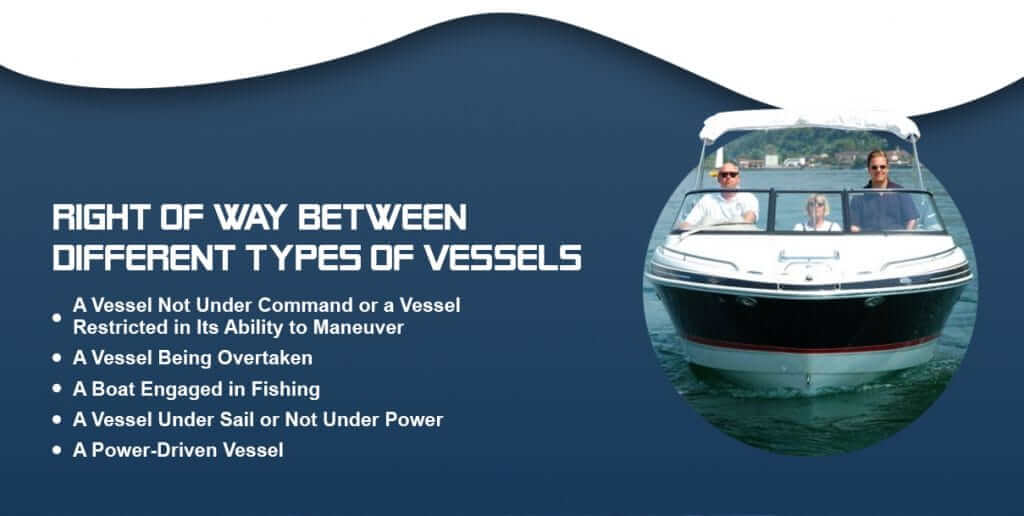
Now that you know the basic rules of the road, we’ll cover a few special situations you may encounter. Besides the basics of power versus non-power boat rules, there’s a pecking order when it comes to the right of way — different vessels and different conditions determine who is the stand-on vessel.
Here’s the U.S. Coast Guard list , from the highest level of right of way to the lowest:
1. A Vessel Not Under Command or a Vessel Restricted in Its Ability to Maneuver
The Coast Guard gives these two types of vessels the same level of priority. A boat “not under command” means that an unexpected circumstance is keeping the boat from maneuvering, like an engine or steering failure.
A vessel that restricted in its ability to maneuver is unable to move out of the way of other boats due to the nature of its work, like a buoy tender fixing a navigational aid or vessel transferring passengers while underway.
2. A Vessel Being Overtaken
Any boat approaching a vessel from astern must give them the right of way.
3. A Boat Engaged in Fishing
When a boat has commercial fishing equipment deployed, that restricts their ability to maneuver. Therefore, they have the right of way.
4. A Vessel Under Sail or Not Under Power
A vessel under sail as well as other watercraft that are not powered, — such as canoes, kayaks, paddleboards, etc. — have the right of way over powered-vessels.
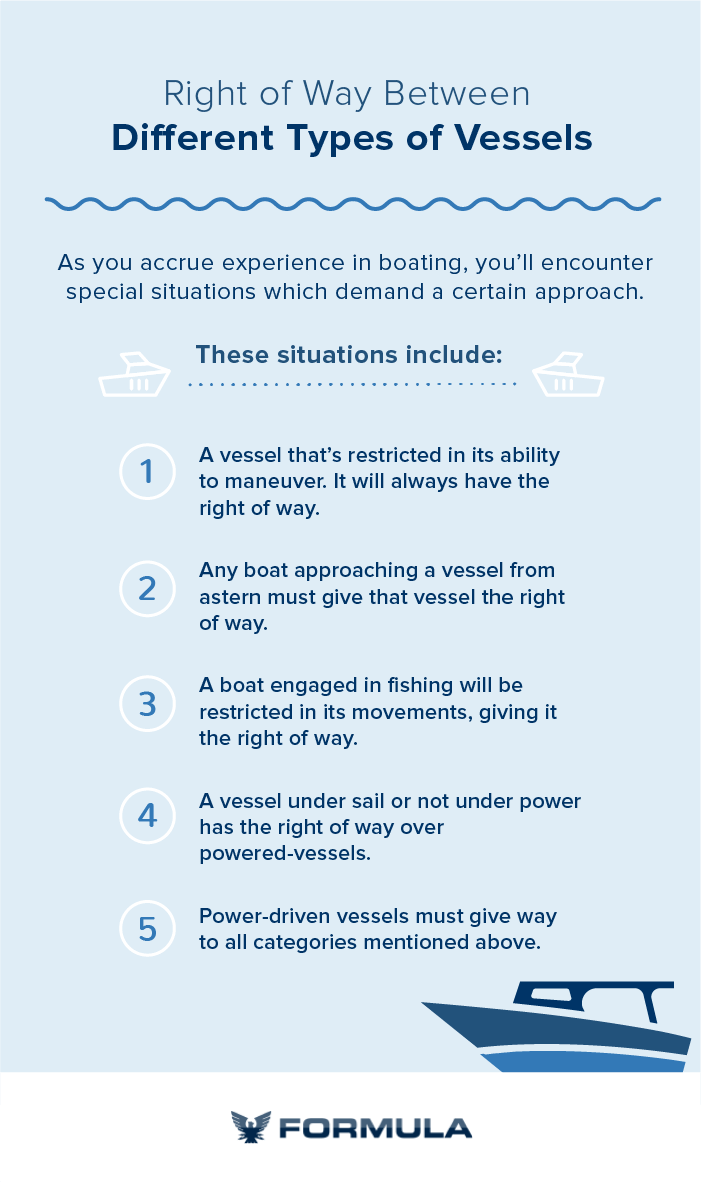
5. A Power-driven Vessel
As a power-driven vessel, you must give way to all the other categories above. If you are converging on another powered boat, either head-on or astern, the right-of-way rules mentioned earlier apply.
A few more unique situations that the Coast Guard doesn’t include on their simplified list are:
- – Whenever you hear a siren or see blue flashing lights on an emergency or law-enforcement vessel, give them the right of way just like you would an ambulance or a police vehicle.
- – Keep an eye out for tugboats and other vessels towing — if in the open ocean, they can have a submerged tow-line with a lot of distance between them and their tow.
- – Always take the stern of large commercial tankers and container ships in the ocean, and never try to cross in front of them. While it may look like they’re not moving, they can be running at over 20 knots .
- – Steer clear of docked or moving ferries — some have submerged cable lines. Watch other boats and how they navigate around the ferry before crossing yourself.
- – Any boat under 65 feet is obligated to steer clear of larger, less maneuverable vessels.
It’s important to maintain a proper lookout at all times when operating your vessel. If your boat is small enough, you may be able to keep track of everything by yourself. If you have a larger boat, you’ll probably want some help from a friend onboard — especially when leaving the dock or landing. Having an extra set of eyes is helpful to any captain, no matter how seasoned.
If you apply these tips and remain alert and responsible when operating your boat, there’s no reason you should get into a collision. If someone who isn’t following the rules happens to bump into you, following the rules only helps your case.
You can find a copy of the USCG Navigation Rules in most boating supply stores, and you can also download it online . It’s a good idea for any boater to carry a copy onboard, and it’s mandatory for any vessel over 39 feet in length. Be sure to look up your state’s navigational rules before you set out, as they may vary depending on location.
Formula Boats for Safety and Performance
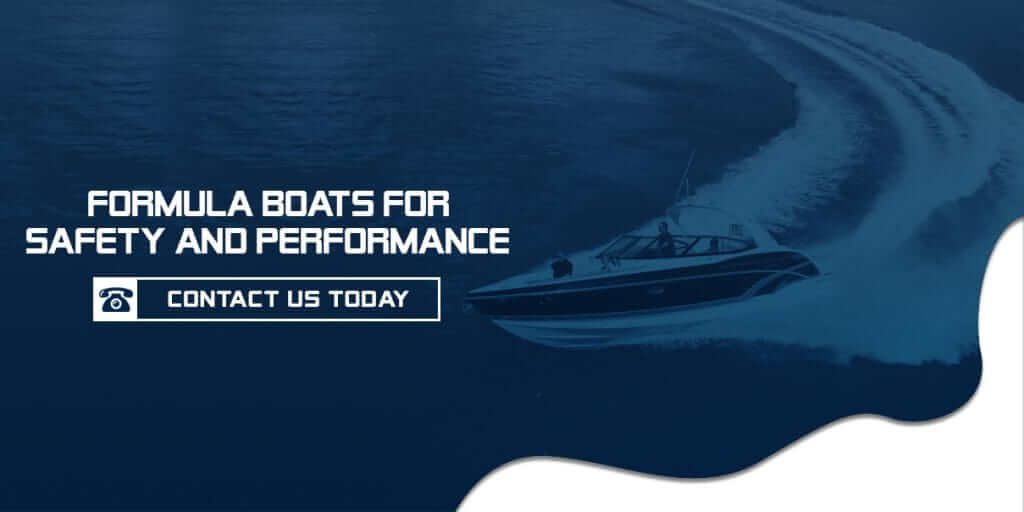
Here at Formula Boats, we take safety seriously. As a family company since 1976, we know the importance of protecting your most valuable assets. Owned and operated by lifelong boaters, the Porter family treats every product as a representation of themselves — that’s why we do everything we can to equip our customers with not only the most reliable boats available, but also the knowledge to be safe such as these boat rules on the water.
Our customers keep coming back because when you own a Formula boat — you’re part of the family. If you’ve thought you can’t have it all in a boat, think again. We don’t make boats for the masses — we make boats for you. With more than 60 years of continued innovation, we make precision watercraft that surpass expectations of quality and performance.
Contact us today for any other boating questions you may have or to request a quote.
Contact Dealer
This site is protected by reCAPTCHA and the Google Privacy Policy and Terms of Service apply

Sailboat vs. Powerboat: Boating Right of Way Rules
Navigating the open waters can be an exhilarating experience and give you a sense of freedom. However, there are rules and responsibilities all captains must follow. Whether steering a small sailboat or cutting through the water in a powerboat, you must understand and adhere to the boating right-of-way rules when other boaters are in the water. These rules refer to the maneuvering regulations designed to avoid a collision between vessels on the water. This guide from ECHOTec will sail into the intricate boating and sailing right-of-way rules, focusing on comparing sailboats and powerboats.
Importance of Understanding Boating Right-of-Way Rules
Imagine yourself gliding across the beautiful ocean, listening to the waves crash onto the side of your hull. With all of the serenity, it is easy to forget that other boats are also navigating their courses. This is where the importance of understanding boating right-of-way rules comes into play.
When you are out on the water, waterways can sometimes become very crowded, just as traffic in a car can be. No yellow or white lines show you what lane to stay in. Therefore, boaters should comprehensively understand the rules when operating a boat. Comprehending these rules can prevent potential accidents out on the water.
When Crossing Paths, What Is the Give-Way Vessel’s Responsibility?
When encountering other vessels that are out on the water, there are two rules every captain/boat operator must follow. The two rules are:
- A give-way vessel is a vessel that must take early and considerable action to get out of the way of other vessels, either by stopping, slowing down, or changing direction to avoid crossing in front of the other boat. The change in course and/or speed must be substantial enough that the other vessels are clearly aware of it.
- A stand-on vessel must maintain its course and speed unless the give-way vessel doesn’t take appropriate action. Therefore, you must change your course to avoid the other boat, ensuring you don’t cross in front of it.
Who Has the Right-of-Way? A Sailboat or Motorboat?
Identifying the key distinctions between sailboats and powerboats is crucial in understanding who has the right-of-way. Sailboats’ primary power source is wind, which allows them to propel forward. This very skillful maneuver requires them to map out their course accurately. On the other hand, motorboats have engines that enable them to quickly accelerate and have precise control over their maneuvers.
These distinctive differences in propulsion and precision handling develop the reasoning for who has the boating right-of-way when navigating through the water. In a situation where a sailboat (without auxiliary power engaged) meets with a small powerboat, the sailboat has the right-of-way due to the difficulty in drastically changing direction quickly. The powerboat must give way to the sailboat and allow them to continue on their desired course.
Sailing Right-of-Way
Now that you know what to do if a powerboat meets a sailboat out on the water, what happens when a sailboat meets another vessel under sail?
The following rules apply based on the circumstances:
- The sailboat on the starboard tack (wind coming over the starboard side) has the right – of – way.
- If both vessels are on the same tack, the leeward boat (downwind) has the right – of – way over the windward sailboat.
- If both sailboats are on the same tack but in a position to pass one another, the vessel being overtaken has the right – of – way no matter the situation.
Navigating Responsibly With ECHOTec Watermakers
Understanding boating right-of-way rules is key for safe and responsible voyages, whether you’re in a powerboat or sailboat. While you embark on your voyage, ensure that your vessel is equipped with sustainable systems such as a sailboat watermaker or powerboat watermaker offered by ECHOTec Watermakers. Advances in sailboat desalination systems have provided reliable freshwater solutions for those at sea. Embrace responsible and safe boating practices, from right-of-way rules to sustainable water options, to create enjoyable journeys. Contact us today to upgrade your boating experience and set sail with confidence on your next voyage.
You May Also Like
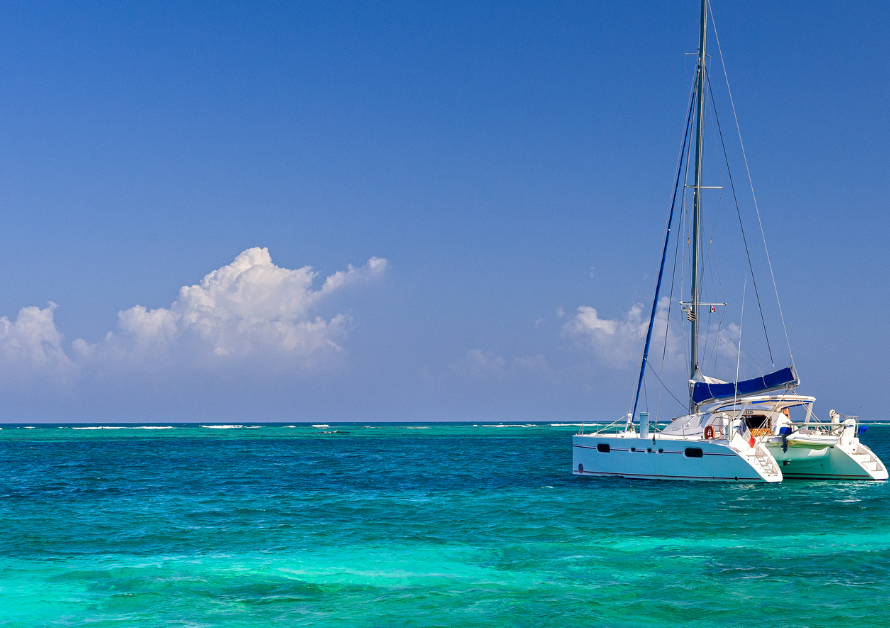
About Catamaran Watermakers
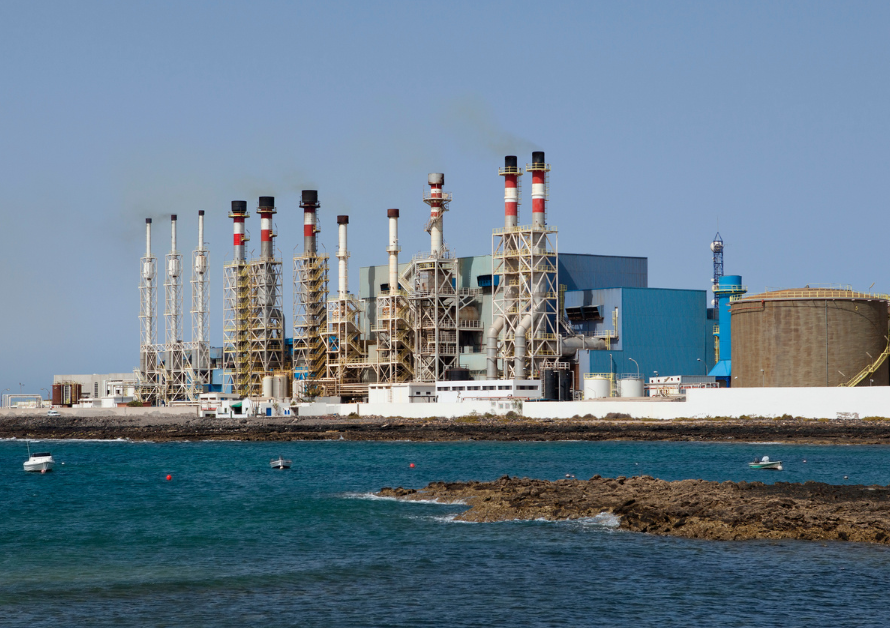
What Equipment Is Used in a Desalination Plant?

- Flashlights
- Path Lights
- Bike Lights

- All Products
- Solar Tiki Torch Lights
- Boat Lights
- UV Black Light
May 20, 2022 9 min read
Give-Way Vessel: Sailboat or Powerboat When Approaching Each Other?

When you're out on the water, it's important to understand the rules of the road to avoid collisions and ensure everyone's safety. One common scenario is when a sailboat and a powerboat are approaching each other. In this situation, which vessel should give way? Understanding the answer to this question can help prevent accidents and keep everyone on the water safe.
To determine which vessel should give way, it's important to understand the terminology used in navigation rules and regulations. This includes terms such as "stand-on vessel" and "give-way vessel." Knowing these terms and what they mean can help you navigate safely and avoid collisions. In the case of a sailboat and a powerboat approaching each other, the vessel that is the give-way vessel should yield to the stand-on vessel.
Key Takeaways
- Understanding vessel terminology is key to navigating safely on the water.
- In an approaching situation between a sailboat and a powerboat, the give-way vessel should yield to the stand-on vessel.
- Knowing the rules of the road and practicing safe seamanship can help prevent accidents.
Understanding Vessel Terminology
Sailboats and powerboats.
When it comes to understanding vessel terminology, it's important to differentiate between sailboats and powerboats. Sailboats are vessels that rely on wind power to move, while powerboats use engines. Sailboats come in different sizes and shapes, from small dinghies to large yachts, and they are often used for recreational purposes. Powerboats, on the other hand, can be used for recreation, transportation, or commercial purposes, and they can range from small fishing boats to large cruise ships.
Stand-On and Give-Way Vessels
Another important aspect of vessel terminology is the distinction between stand-on and give-way vessels. The stand-on vessel is the one that has the right of way and is required to maintain its course and speed. The give-way vessel is the one that must take action to avoid a collision by altering its course or speed. In general, sailboats are considered stand-on vessels, while powerboats are considered give-way vessels.
Underway Definition
Finally, it's important to understand the definition of the term "underway." A vessel is considered underway when it is not at anchor, aground, or tied to a dock. This means that even if a sailboat is not actively sailing, but is instead drifting or using its engine to maintain its position, it is still considered underway. Similarly, a powerboat that is idling or drifting is also considered underway. Understanding this definition is important because it determines which rules of navigation apply to a particular vessel.
In summary, understanding vessel terminology is crucial to safe and effective navigation on the water. By knowing the difference between sailboats and powerboats, stand-on and give-way vessels, and the definition of underway, you can ensure that you are following the correct rules of navigation and avoiding potential collisions with other vessels.
Navigation Rules and Regulations
International rules.
When a sailboat is approaching a powerboat, it is important to know which vessel has the right-of-way. The International Rules specify that a sailboat is generally the give-way vessel and should keep clear of powerboats. However, there are some exceptions to this rule, such as when the powerboat is overtaking the sailboat or when the sailboat is operating in a narrow channel.
Right-of-Way
The right-of-way is the privilege of one vessel to proceed ahead of another vessel in a particular situation. In general, powerboats have the right-of-way over sailboats because they are more maneuverable and can change course more quickly. However, there are some situations where the sailboat has the right-of-way, such as when it is on a collision course with a powerboat.
The term "keep clear" means that a vessel must take early and substantial action to avoid a collision by altering its course and/or speed. Sailboats must keep clear of powerboats and take action to avoid a collision, even if they have the right-of-way. This may include changing course or speed, or using sound or light signals to communicate with the powerboat.
In summary, when a sailboat is approaching a powerboat, it is important to follow the Navigation Rules and Regulations to avoid a collision. The International Rules specify that a sailboat is generally the give-way vessel, but there are exceptions to this rule. The right-of-way is the privilege of one vessel to proceed ahead of another vessel in a particular situation, and the term "keep clear" means that a vessel must take early and substantial action to avoid a collision.
Overtaking and Crossing Situations
Overtaking rules.
When a sailboat is approaching a powerboat from behind, the sailboat is the give-way vessel. The sailboat must keep clear of the powerboat and should not overtake until it is safe to do so. The powerboat has the right of way and should maintain its course and speed.
Crossing Paths
When a sailboat and a powerboat are approaching each other on crossing paths, the powerboat is the give-way vessel. The sailboat has the right of way and should maintain its course and speed. The powerboat should alter its course to avoid a collision.
Sound Signals
In some situations, sound signals may be used to communicate between boats. When a sailboat is overtaking a powerboat, the sailboat should sound one short blast to indicate its intention to overtake. When a powerboat is altering its course to avoid a sailboat, it should sound one short blast to indicate its intention.
Remember, safety is the top priority when boating. Always be aware of your surroundings and follow the rules of the waterways .
Port, Starboard, and Stern
When a sailboat is approaching a powerboat, it is important to know which vessel has the right of way. The port side of a boat is the left side when facing the bow. If a sailboat and a powerboat are approaching each other and the sailboat is on the port side of the powerboat, the sailboat is the give-way vessel. This means that the sailboat must yield the right of way to the powerboat and take appropriate action to avoid a collision.
Starboard Side
On the other hand, the starboard side of a boat is the right side when facing the bow. If a sailboat and a powerboat are approaching each other and the sailboat is on the starboard side of the powerboat, the sailboat has the right of way. In this case, the powerboat is the give-way vessel and must take appropriate action to avoid a collision.
Stern Definition
The stern of a boat is the back end. When a boat is approaching another vessel from behind, it is important to keep a safe distance and avoid getting too close. The vessel in front has the right of way, and the vessel approaching from behind must yield and take appropriate action to avoid a collision.
Remember, it is important to always be aware of your surroundings and take appropriate action to avoid collisions. Following the rules of the water and using common sense can help prevent accidents and keep everyone safe.
Safe Speed and Seamanship
Maintaining safe speed.
When approaching a powerboat, it is important to maintain a safe speed. This means that you should be traveling at a speed that allows you to take appropriate action if necessary. You should also be aware of any speed limits in the area and adjust your speed accordingly. Additionally, it is important to be aware of the wake that your boat is creating and how it may affect other vessels in the area.
Seamanship Skills
Good seamanship skills are essential when approaching a powerboat. This includes being aware of your surroundings and maintaining a lookout for other vessels. You should also be aware of the rules of the road and any local regulations that may apply. Additionally, you should be prepared to communicate with the other vessel and take appropriate action if necessary.
Maneuverability
Maneuverability is also important when approaching a powerboat. You should be able to maneuver your sailboat quickly and effectively in order to avoid a collision. This may involve using techniques such as tacking or jibing, or simply adjusting your course or speed. Additionally, you should be aware of the other vessel's maneuverability and be prepared to adjust your own course or speed accordingly.
By maintaining a safe speed, using good seamanship skills, and being aware of your boat's maneuverability, you can ensure a safe and enjoyable experience when approaching a powerboat. Remember to always be aware of your surroundings and take appropriate action to avoid a collision.
Powerboats and Personal Watercraft
Powerboat handling.
When a sailboat is approaching a powerboat, the powerboat is usually the give-way vessel. However, it is important to note that powerboats have different handling characteristics compared to sailboats. Powerboats can stop or change direction quickly, but they also have a larger turning radius. Therefore, it is important for powerboat operators to be aware of their surroundings and take necessary actions to avoid collisions.
Personal Watercraft Use
Personal watercraft, such as jet skis, are also considered powerboats. However, they have different handling characteristics compared to traditional powerboats. Personal watercraft are highly maneuverable and can quickly change direction, but they also have a shorter stopping distance. Therefore, it is important for personal watercraft operators to be aware of their surroundings and take necessary actions to avoid collisions.
In summary, powerboat operators and personal watercraft operators should always be vigilant and aware of their surroundings when on the water. It is important to follow boating laws and regulations to ensure the safety of everyone on the water.
Meeting Head-On and Other Scenarios
Head-on encounters.
When a sailboat and a powerboat are approaching each other head-on, the powerboat is the give-way vessel. As a sailboat, you should maintain your course and speed, and the powerboat should alter its course to avoid a collision. If you are unsure whether the powerboat has seen you or not, you can signal your presence by waving your arms or sounding your horn.
Overtaking Scenarios
When a sailboat is overtaking a powerboat, the sailboat is the give-way vessel. As a sailboat, you should alter your course to avoid a collision, and the powerboat should maintain its course and speed. If you are overtaking a powerboat, make sure you do it on the side where the powerboat's operator can see you.
In all scenarios, it is important to keep a safe distance from other vessels. The distance should be enough to allow you to maneuver in case of an emergency. Always be aware of your surroundings and keep a lookout for other boats, buoys, and other objects in the water.
Remember that the rules of the road apply to all vessels, including sailboats and powerboats. By following these rules, you can ensure a safe and enjoyable boating experience for everyone involved.
Frequently Asked Questions
What is the give-way vessel when a sailboat is approaching a powerboat.
When a sailboat is approaching a powerboat, the powerboat is the give-way vessel. The sailboat has the right of way, and the powerboat must take action to avoid a collision. This is because sailboats are less maneuverable than powerboats and require more time to change course.
What should you do to avoid colliding with another vessel?
To avoid colliding with another vessel, you should keep a proper lookout and be aware of other boats in the area. You should also follow the rules of the road and give-way to other boats when necessary. If you are unsure about what to do, slow down or stop your vessel until you can safely navigate around the other boat.
Why should a vessel operator keep a proper lookout?
A vessel operator should keep a proper lookout to avoid collisions with other boats, objects, or hazards in the water. This includes keeping an eye out for other boats, swimmers, and floating debris. A proper lookout can help prevent accidents and ensure the safety of everyone on board.
One boat is overtaking another which boat must give-way?
When one boat is overtaking another, the boat being overtaken is the give-way vessel. The overtaking boat must keep clear of the other boat and give it enough room to maneuver. The boat being overtaken should maintain its course and speed until the overtaking boat has passed.
When a power boat meets a sailboat who has the right of way?
When a power boat meets a sailboat, the sailboat has the right of way. This is because sailboats are less maneuverable than powerboats and require more time to change course. The powerboat must take action to avoid a collision and give the sailboat enough room to maneuver.
When would the sailboat be the give way vessel?
There are some situations where the sailboat would be the give-way vessel. For example, if a sailboat is crossing in front of a powerboat, the sailboat must give-way to the powerboat. Similarly, if a sailboat is overtaking another boat, it must keep clear of the other boat and give it enough room to maneuver.

- CREATE AN ACCOUNT
- Boat Cover Finder
- Bimini Top Finder
- Boat Propeller Finder
- Engine Parts Finder
- Anchor & Dock
- Watersports
- Clothing and Footwear
- Engine Parts
- Cabin and Galley
- Covers and Biminis
- Electronics
- Paint and Maintenance
- Pumps and Plumbing
- Anchor Chains & Ropes
- Boat Fenders
- Boat Mooring
- Boat Protection
- Dock Storage & Protection
- Ladders, Steps, & Platforms
- Top Sellers

- Fishing Rods
- Fishing Reels
- Fishing Rod & Reel Combos
- Fishing Tools & Tackle Boxes
- Fishing Line
- Fly Fishing
- Fishing Bait & Fishing Lures
- Fishing Rod Holders & Storage Racks
- Fish Finders, Sounders & Sonar
- Trolling Motors
- Fishing Nets
- Fishing Downriggers & Acessories
- Fishing Outriggers & Acessories
- Fishing Kayaks
- Fish Cleaning Tables

- Inflatable Rafts
- Paddle Boarding
- Paddles & Oars
- Wakeboard, Wakesurf & Ski
- Wakeboard Towers
- Tow Ropes & Handles
- Life Jackets & PFDs
- Snow Sports
- Roof Racks, Carriers, Dollies

Men's Clothing
- Accessories
Men's Footwear
- Atheltic Shoes
- Water Shoes
Women's Clothing
- Dresses & Skirts
Women's Footwear
- Fuel Systems
- Sacrificial Anodes & Zincs
- Generator Parts
- Inflatable Boats
- Propeller Parts & Accessories
- Boat Manuals
- PWC Parts & Accessories

- Fishing Boat Seats
- Offshore Boat Seats
- Ski Boat Seats
- Pontoon Boat Seats & Furniture
- Boat Seat Pedestals & Hardware
- Boat Seats by Manufacturer
- Boat Tables & Hardware
- Boat Seat Covers
- Boat Seat Vinyl
- Floating Boat Cushions

- Barbeque Grills
- Boat Drink Holders
- Cabin Accessories & Hardware
- Boat Ventilation
- Interior & Cabin Lighting
- Marine Teak Products
- Carbon Monoxide & Smoke Detectors
- Binoculars & Telescopes

Boat Bimini Tops
- Bimini Top Accessories
- Pontoon Bimini Tops
- Other Biminis
- RV & Trailer Covers
- Boat Shrink Wrap & Accessories
- Boat Shelters
Boat Covers
- Boat Cover Accessories
- Boat Lift Canopy Covers
- Other Covers
- Boat Wiring & Cable
- Marine Batteries & Accessories
- Marine DC Power Plugs & Sockets
- Marine Electrical Meters
- Boat Lights
- Marine Electrical Panels & Circuit Breakers
- Power Packs & Jump Starters
- Marine Solar Power Accessories
- Marine Electrical Terminals
- Marine Fuse Blocks & Terminal Blocks
- Marine Switches
- Shore Power & AC Distribution

- Marine Audio & Video
- GPS Chartplotters & Accessories
- Electronic Navigation Charts & Software
- Digital Instruments
- Display Mounts
- VHF Radios & Communication
- Marine Radar
- Auto Pilot Systems
- Action Cameras

- Fiberglass & Epoxy Boat Repair
- Boat Paint & Varnish
- Marine Adhesives, Sealant, & Caulking
- Marine Engine Maintenance
- Boat Cleaners & Waxes
- Boat Cleaning Supplies

- Fresh Water Boat Systems
- Bilge Pumps
- Marine Plumbing Parts
- Wash Down Pumps
- Livewell Aerator Pumps & Live Bait Wells
- Toilet & Waste Pumps
- Marine Pump Replacement Parts

- Tires, Rims, & Hub Kits
- Boat Trailer Winches
- Boat Motor Supports & Transom Savers
- Boat Trailer Guides & Rollers
- Boat Trailer Fenders
- Boat Trailer Lights
- Boat Trailer Hardware
- Boat Trailer Jacks
- Boat Trailer Brakes & Axles
- Boat Trailer Tie Downs
- Couplers, Mounts, Hitches, & Locks

- Boat Deck Harware
- Marine Nuts, Bolts, & Screws
- Boat Handles, Pulls, & Rings
- Prop Nut Kits & Hardware
- Boat Cabin Hardware
- Marine Fasteners
- Boat Windshield Parts
- Boat Tubing & Rails
- Boat Mirrors
- Marine Tools & Tool Kits
- Boat Lettering

- Women's Clothing Deals
- Men's Clothing Deals
- Fishing Deals
- Anchor & Dock Deals
- Electrical Deals
- Electronics Deals
- Paint & Maintenance Deals
- Pumps & Plumbing Deals
- Boat Seats Deals
- Trailering Deals
- Camping & RV Deals
- Dealer Login

- Forums Login

- Search forums
- The iboats forum moderators are excited to announce that at this time it appears the iboats forums posting pictures function is working once again. Though we cannot promise for how long, we're hoping for indefinitely.
- General Boating/Outdoors Activities
- Boat Topics and Questions (not engine topics)
Sailboat vs. Powerboat and Rights of Way.
- Thread starter UncleWillie
- Start date Oct 28, 2012
UncleWillie
- Oct 28, 2012
This happened a few months ago and had a very uneventful ending but I keep thinking about it. I was approaching the entrance to a river with extended jetties on both sides of the entrance channel. The channel was about 100 yards wide and is normally not anything of an issue. If the inbound craft and outbound craft line up and go single file there is plenty of room for everyone. Back to the story. I was in an 18ft I/O and still running fast in open water when I noticed I was going to tie an inbound 35ft sailboat under sail. So, still about a 1/4 mile out, I made sure to keep the power up as I did not want to end up following a really slow sailboat up the channel once he dropped the sail and started his little kicker. I entered the channel at least 100 yards ahead of the sailboat and dropped to my no wake speed of about 5mph. The sailboat entered the channel well and clear behind me. This is where it get interesting. The sailboat did not drop sail and kept on coming at about 7 mph up the channel. In short time he was directly off my port quarter and coming on. I gave way a little to Starboard but had no room to go as the rock jetty was was not all that far away. In due course the sail boat was passing me maybe 10 ft off my port beam. This was my definition of being between the rocks and a hard place! Too close for my comfort! Now, discretion being the better part of valor; I cut all power and just let him go by before anything became any more exciting. (Rule Of Tonnage!) I keep running the rules through my head... On one hand the Sailboat is the Stand-On vessel against a Power boat. On the other hand the Passing vessel is the Give-Way vessel. There is nothing in the rules about a Sailboat passing a Powerboat! Stand-On or Give-Way; You make the call!
Lieutenant Junior Grade
Re: Sailboat vs. Powerboat and Rights of Way. If he gets in front of you he has the Right of Way. Your application of the Rule of Tonnage was wise. The sailboat, with its displacement hull probably has a higher no-wake speed than your planing hull. I'm with Give-Way.
theBrownskull
Chief petty officer.
Re: Sailboat vs. Powerboat and Rights of Way. I would have give way too.
Tail_Gunner
Re: Sailboat vs. Powerboat and Rights of Way. I boat in a large sailing community....alway's give them discretion your under power.. you might as well slam a door in a lady's face the result's are the same..
Re: Sailboat vs. Powerboat and Rights of Way. Wind is free,so is the right of way........sailboats,kyakers,canoeists, own the water.......Don't get me started!
rallyart said: If he gets in front of you he has the Right of Way... Click to expand...
The Overtaking Situation Any vessel overtaking any other vessel must keep out the way of the vessel being overtaken. The former is the give-way vessel and the latter is the stand-on vessel. This rule applies even if the overtaking vessel is propelled by wind , oars, or rubber band paddlewheel. If you are the overtaking vessel, remember that you are the give-way vessel until well past , and safely clear of, the overtaken vessel. Click to expand...
The "Pecking Order" There is a "pecking order" that can be used as a simplified memory aid to determine right of way for vessels of different types. Get very familiar with this list, as it is important to understand it thoroughly. The uppermost vessel on the list has right-of-way (stand-on vessel) over any vessel (give-way vessel) below it on the list: Overtaken vessel (top priority) <---<<< Vessel not under command Vessel restricted in its ability to maneuver <---<<< Vessel constrained by its draft Fishing vessel (commercial fishing or trawling but not trolling) Sailing vessel (engine not on) Power-driven vessel (lowest priority) Click to expand...
Re: Sailboat vs. Powerboat and Rights of Way. I have stood on a busy jetty entrance in north New Jersey. Tide is roaring in or out. Kamakazis both ways at the same time. In heavy fog. ( I am using radar !!!! ) Private boats & commerical fish trawlers. Fog so heavy I could not see a boat 50' away !! At least 1 or 2 top heavy cruisers underpowered, would lose it and bang the rocks or run aground past the jetties on a busy weekend with fog. Coast guard courses NEVER cover jetty conditions in the area a boater will use. If people saw the crap headed actions in THEIR confined waters, they would sell the boat right after the movie & popcorn ended.
Re: Sailboat vs. Powerboat and Rights of Way. Really no question here. If the sailboat was overtaking you, you were the stand on vessel and were obligated to hold course & speed, and the sailboat was the give way vessel and was obligated to alter course & or speed. In this situation (sailboat overtaking a powerboat) it makes no difference that he was a sailboat. That's the law. As for his decision to come in under sail, if the wind was favorable he may have had MUCH better control under sail than under auxiliary.
Lieutenant Commander
Re: Sailboat vs. Powerboat and Rights of Way. Sometimes you have to ignore the no wake zone when you are dealing with inltets, strong currents, and jettys. Just do what you have to do to make it from the ocean to the bay. And don't hit any rocks or boats. everyone is happy. BTW, A boat under sail, can still stop on a dime. You just have to release 2 lines, and let your sails heave to in the wind. (let them flap around, with no tension on the control lines, and worry about the rest later)
- Oct 29, 2012
Re: Sailboat vs. Powerboat and Rights of Way. much like folks on bicycles who ride in the middle of the lane, I have problems with people who may well be legally correct but who have no consideration for anyone else .... to me, jet ski operators who cut as close as they can to the back of our boat so as to jump the wake fall in that group as do folks paddling a shallow draft boat choosing to block the middle of the channel .... since I can't control what they do I've evolved to where I let them go and don't worry about it .... for us, time on the water is relaxing and getting stressed over such things makes it far less enjoyable Jim
Re: Sailboat vs. Powerboat and Rights of Way. This may have had nothing to do with "no consideration for anyone else". I haven't read any indication that the sailboat did anything 'wrong' (though passing with only 10 feet is certainly discourteous, unnecessary, and may have constituted poor judgement). If I were coming in an inlet and the wind were favorable I well might prefer coming in under sail as well. If I found myself overtaking an 18' I/O and he chose to keep moving toward the rocks I can't control that. The law says I have to maneuver around him, if he keeps moving to one side I can't control that, and then if he is not in front of me I have no action to take. To say that the wake from a sailboat is 'excessive' is (usually) a bit of a stretch. If I am coming in a nasty inlet I'm going to do it in the way that I have the best control of my situation, which is usually also the safest.
Petty Officer 1st Class
Ned L said: Really no question here. If the sailboat was overtaking you, you were the stand on vessel and were obligated to hold course & speed, and the sailboat was the give way vessel and was obligated to alter course & or speed. In this situation (sailboat overtaking a powerboat) it makes no difference that he was a sailboat. That's the law. As for his decision to come in under sail, if the wind was favorable he may have had MUCH better control under sail than under auxiliary. Click to expand...

COMMENTS
The Rules are simple when a sailboat and a small recreational powerboat meet: In most situationsthe sailing boat is the stand-on vesseland the powerboat must give way. If the sailboat is overtaking a powerboat, the powerboat is the stand-on vesseland the sailboat must give way. Any boat with more maneuverability must give wayto any boat with ...
Right of Way Rules. Whenever you meet another boat, it's like approaching an unmarked intersection in your car. Knowing a few, simple right of way rules will help you avoid a collision. ... Remember, if being propelled by a motor, a sailboat is considered to be a powerboat. Vessels Engaged in Fishing - Means any vessel fishing with nets ...
Navigating the waters is an exciting adventure, whether you're at the helm of a sleek sailboat or commanding a powerful motorboat. However, along with this thrilling journey comes the responsibility of understanding and adhering to the marine navigation rules, specifically those concerning the right of way or the "give-way" vessel.
Note: A sailing boat which is motor sailing does not have priority over a power boat, even if it has sails hoisted. Sailing boat hierarchy. Port tack gives way to starboard tack. If on the same tack, the windward boat gives way. If it is unclear to a sailing boat on port tack which tack another sailing boat to windward is on, then the boat on ...
A sailboat is on the port tack when the boom is on the starboard side (or right side). Powerboat vs. Powerboat Powerboats include a sailboat under power, even if the sails are still up: the boat on the starboard (right) side has the right of way. Overtaking Boats A boat overtaken by another boat has the right of way. The boat being overtaken ...
Sailboats have right of way over powerboats in almost all cases. The exception being when the sailboat is overtaking the powerboat and certain unique situations. If two boats are crossing, then the one on the starboard side has the right of way. In situations where it is dark, you will be able to see a red light moving across your horizon to ...
Here are the Simple Right of Way Rules (not to be confused with reality): Sailboat vs. Powerboat. A sailboat under sail has the right of way over a powerboat. A sailboat under power becomes a powerboat — see below. Sailboat vs. Sailboat. Both boats on the same tack: the leeward boat has the right of way. Boats on opposite tacks: the boat on ...
There are just three sailboat-to-sailboat rules: 1. When on the same tack, the leeward boat has the right-of-way. 2. When on opposite tacks, the starboard tack boat has the right-of-way. 3. When overtaking, the overtaken boat has the right-of-way. The rules require the stand-on vessel to maintain course and speed, but they also obligate both ...
The only situations in which a sailboat under sail has to change course of speed to avoid a powerboat are when the powerboat is anchored or tied to the shore, and when the sailboat is overtaking the powerboat. The sailboat/powerboat rules trump the crossing situation rules in #1 above.
If a sailboat is overtaking a power boat, the power boat has the right of way. Passing - When any boat is passing another boat, the passing boat is tile give way boat and tile boat being passed is the stand on boat. Head On - When two motor boats approach each other head on, both boats turn to the right and pass each other port to port.
Sailboats require a more hands-on approach, which many people prefer. Yet, powerboats have less maintenance and more speed. Which kind of boat you choose depends entirely on what kind of experience you want to have. Powerboats are easier to operate, and they require a little experience. But, they are costly to keep running and you're reliant ...
A System for Remembering Who's "Give Way" and "Stand On" Vessel While Boating. This is a question one hears frequently when sailing and boating in crowded conditions. The answer is: No One Has the Right of Way! The Navigation Rules - International and Inland are published by the Department of Homeland Security and are enforced in US ...
A sailboat always has the right-of-way over a powerboat (unless the sailboat is overtaking the powerboat, in which case the sailboat becomes the give-way craft). The following rules determine which boat has the right-of-way when a sailboat approaches another sailboat: Wind on Different Sides:
n the right-o. -way by any rule of this section.(b) Crossing. When aircraft, or an aircraft and a vessel, are on crossing courses, the aircraft or v. ssel to the other's righ. has the right-of-way.(c) Approaching head-on. When aircraft, or an aircraft and a vessel, are approaching head-on, or nearly so, each shall a. ter its course.
Sailing Right of Way. When two boats that are both under sail meet, the following rules apply: The boat on a starboard tack has the right of way—the wind coming over the starboard rail. When two vessels are on the same tack (the wind is coming from the same side), the leeward boat (downwind) has the right of way over the windward boat (that ...
Rule 2: When you are on opposite tacks, the starboard tack boat has the right-of-way. Rule 3: If you are overtaking the other boat, or it is overtaking you, the boat ahead (the overtaken boat) has the right-of-way. In Figure 8-2, two boats are approaching each other and subject to the same tack rule. Sailors refer to the boat with right-of-way ...
Both boats should veer right. Ryan Swanson. There is no right of way on the water. Every boater is obligated to do what is required to avoid collision. In any meeting of boats, one is deemed the stand-on vessel and the other the give-way vessel. The rules of the road explain the situation more completely and can be learned in a boating safety ...
Operating Rules - Keeping it Simple. Port: If a power-driven boat approaches your boat from the port sector, maintain your course and speed with caution. You are the stand-on craft. Starboard: If any vessel approaches your boat from the starboard sector, you must keep out of its way. You are the give-way craft.
1. If another vessel is approaching you from the port — or left — side of your boat, you have the right of way and should maintain your speed and direction. 2. If a vessel is aiming to cross your path and they're on your starboard — or right — side, they have the right of way.
Whether steering a small sailboat or cutting through the water in a powerboat, you must understand and adhere to the boating right-of-way rules when other boaters are in the water. These rules refer to the maneuvering regulations designed to avoid a collision between vessels on the water.
The port side of a boat is the left side when facing the bow. If a sailboat and a powerboat are approaching each other and the sailboat is on the port side of the powerboat, the sailboat is the give-way vessel. This means that the sailboat must yield the right of way to the powerboat and take appropriate action to avoid a collision.
Re: Sailboat vs. Powerboat and Rights of Way. The sailboat was still making full sail power in confined quarters,nickels & dimes. Report him as reckless !! He did the right thing by keeping sail up & maintaining good steering speed if needed in a jetty current area. You should have added enough speed to keep at least 100' ahead of him.
For example, a sailboat that is under sail and not being powered by an engine is considered to be less maneuverable than a powerboat and therefore has the right of way over the powerboat. Whether you have the right of way or not, it is your responsibility to avoid a collision. Remember, stopping a boat is always an option. Give Way Vessel